
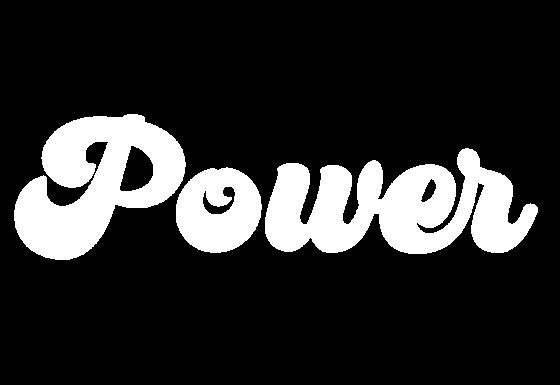
MODA FALL PRINT 2021 THE ISSUE HOW VIDEO REALLY DID KILL THE Radio Star Moda's Favorite ICONS GLAM ROCK OF THE '70s and '80s
EDITOR IN CHIEF
Gabrielle Gronewold
DEPUTY EDITOR
Arella Warren
ART DIRECTOR
Annika Ide
ARTS CURATOR
Emma Gray
PHOTOGRAPHY DIRECTOR
Audrey O’Neill
CREATIVE DIRECTOR
Sam Starks
FASHION DIRECTOR
Corbin Woessner
FASHION EDITOR
Manon Bushong
LIFESTYLE EDITOR
Mason Braasch
CULTURE EDITOR
Rachel Hale
ARTS EDITOR
Kora Quinn
ON THE COVER
Robbi Varona photographed by Audrey O'Neill, Photography Director
SOCIAL MEDIA MANAGER
Olivia Peters
PR AND OUTREACH DIRECTOR
Emily Fleming
ONLINE EDITOR
Jessica Katz
NEW MEMBERS DIRECTOR
Maya Greenberg
PROGRAMMING AND SPECIAL EVENTS COORDINATOR

Madeleine Olson
DIVERSITY AND INCLUSION CO-DIRECTORS
Abbey Perkins
Sonakshi Garr
MAKEUP DIRECTOR
Riley August
VIDEOGRAPHY DIRECTOR
Madelyn Vilker
WEBSITE MANAGER
Kara Conrad
MODA IS PRODUCED WITH SUPPORT FROM THE WISCONSIN UNION AND WISCONSIN UNION DIRECTORATE PUBLICATIONS COMMITTEE.

WRITERS
Mason Braasch • Manon Bushong • Tessa Devine • Emily Fleming • Sonakshi Garr • Maya Greenberg • Gabrielle Gronewold • Rachel Hale • Jane Houseal • Nina Johnson • Jessica Katz • Alexandra Mack • Olivia Peters • Kora Quinn • Alison Stecker • Cate Tarr • Arella Warren
ART
Riley August • Mac Gale • Nicole Glesinger • Emma Gray • Annika Ide • Alexa Kantor • Kate Madigan • Sammy Meyerson • Shea Murphy • Rosie Quinlan • Jessica Tenenbaum • Arella Warren • Haley Wolff
PHOTOGRAPHY
Evelyn Barrios • Seth DeGier • Hannah Huber • Molly Jacobs • Hunter Kiehl • Audrey O'Neill • Bela Orzechowski • Jessica Tenenbaum
MODELS
Winnie Bishop • Ella Cunz • Sonakshi Garr • Rachel Hale
• Emily Herzog • Alexandra Mack • Clara McKinney • Brenna Paul • Timothea Stinnet • Kamryn Truesdale
• Robbi Varona • Austen Wallenfang
MODA | 2 TEAM
TABLE OF CONTENTS
CULTURE
05
Farrah Fawcett and Madonna: Shear Forces in Directing Change

Two of the biggest influencers from the '70s and '80s
10
Dancing with my Mother Tongue
How I returned to my power through celebrating Punjabi
16
Cults, Conspiracies and Corruption
The rise and evolution of the American cult mentality
28
The Man Who Defined 1980s New York City
Celebrating documentarian Nelson Sullivan
38
AIDS in America
How the federal government let down its citizens–and how communities stepped up in its place
FASHION
06 Rockin' a New Masculinity
From David Bowie to Harry Styles to us

26 More is More
Notes on Maximalist Fashion
35
Female Fashion Powerhouses
Two women who changed the course of fashion forever
40
The New Meaning of a Fashion Statement
Social activism through fashion
LIFESTYLE
14
Through Lands and Slams
The femme and queer skate community of Madison
ARTS
08
Contemporary Art's Power Trifecta
How Basquiat, Warhol and Haring persist through the decades
11
Sex, Drugs and Rock & Roll
Glam rock's impact on the '70s and '80s
24
Video Killed the Radio Star
How MTV revolutionized the entertainment industry and pop culture


37 Make way, Hollywood
The growing power of female directors
41 How Children's Books Pack a Punch
Why we shouldn't underestimate middle-grade fiction
23
Lessons from My High School Speech Coach
Five tips to improve your public speaking skills
36 The Power of Doing
A conversation about why dreams shouldn't just be lived in the future
FEATURED
18 Groove 30 Kinetic
FALL PRINT 2021
LETTER FROM THE EDITOR
THE POWER WITHIN
Dear Readers & the Moda Team,

It seems like today everyone wants to leave an impact. We want to be re membered and important and innova tive. Gen Z is known for being a gen eration of influence and change—as I believe all generations in their prime youth probably are. It may be argued that everyone trying to leave an im pact dilutes the efforts we make and over floods our world. And I think there is some validity in that. But I would be lying if I didn’t say that when the Moda Editorial Board sat down to choose our Fall Print issue theme, we didn’t think about the value in leaving an impact.
Derived from the Latin word “potere,” meaning ‘to be able,’ the word “power” at its core means to do something in a particular way or to have the ability to direct or influence others. However, this lackluster definition doesn’t unveil the sexiness that the word “power” tru ly encompasses. Power, in all its glory, is what captures a moment, a person or a word and allows for an explosive, eternal impact. As we all strive to make our own impact in this world, power is the secret sauce that gets us there.
In truth, “power” at its darkest has ig nited wars, created systems of oppres sion and silenced individuals. In light of power’s capabilities, the bloodbath for it persists and the human desire to be the most powerful in a room remains innate. Maya Greenberg’s article on “AIDS in America” articulates just how deadly this concept can be. When HIV first emerged in the U.S., there was im mense collective fear. Despite having the resources and capability to pro vide solutions, the American govern ment didn’t act fast enough, or nearly at all. This remains a tragic example of neglect and corruption in our country and ultimately shows us that “to be able” does not equate to being good.
Enter Voltaire’s philosophy, that “with great power comes great responsibili ty.” Later popularized through the Spi der-Man comics, this mentality expands the meaning behind power to go much deeper than ability or sheer influence.
Manon Bushong’s “The New Meaning of a Fashion Statement” defines the emerging trend of fashion activism for all it’s worth. While some brands are hopping on the bandwagon with performative claims, others are taking
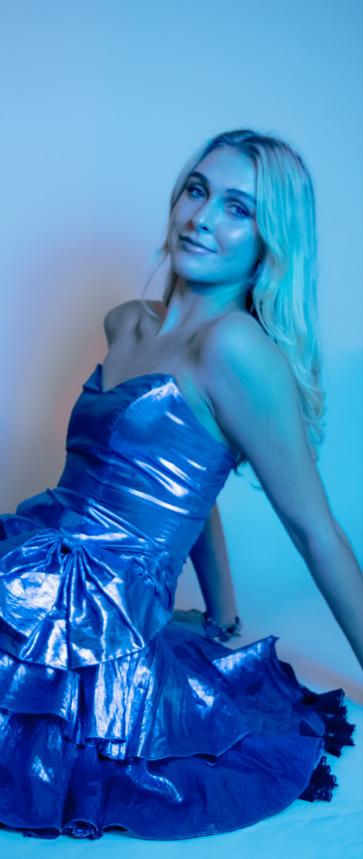
actionable strides toward authentic, social change—fully grasping what is meant by power’s responsibility.
Beyond our social understandings of power lies our personal power, some thing our society doesn’t always fully acknowledge or celebrate. Sonak shi Garr’s “Dancing with my Mother Tongue” offers an intimate and signif icant narrative and cultural analysis of language and identity. Understanding who we can be outside of society’s gaze requires an inner power we’re not given enough credit for, something we can admire and learn from Garr.
On the whole, what’s special about this issue is that it is Moda’s first print issue as an independent publication—how powerful! This past semester, the Moda team took a big risk in recentering our organization. If you had asked me three weeks ago from when I sit here writing this about doing a print issue, I’d have had no idea if we’d be able to take print on this semester. I don’t know why I was surprised when we ac complished the feat, however, because the Moda team is incredibly smart and incredibly powerful.
I speak on this because I think it marks an important moment in Moda’s past, present and future, and also because I think it sheds light on how we’re all trying to make an impact—and how we all may actually be doing it.
In and of itself, trying to leave an im pact is quite vulnerable. It’s the desire of wanting to be seen, to be valued and to improve the lives of others. Some times we try so hard to do this that we may not notice when we actually do.
I know Moda makes content for our readers, but I also know that each per son who contributes to this publication contributes due to the deep inner pas sions and emotions within themselves. I know you, as a reader, may relate to that through your own endeavors. I am unsure if you as a reader or the people who bring Moda to life truly know your own power. It’s not something that can be easily put into words, but I am con fident if you sit back and reflect for a moment, you may begin to visualize the impact you truly have.
Undoubtedly, for better or for worse, power is a force to be reckoned with. This issue uncovers the darkness that
lies behind power and the ways in which it has hurt people. It also pro nounces the light in power and the ways in which our world is improved both culturally and intimately by force and influence. Let the dynamics of power lead you to new ideas and new reflections on who you are.
And to the Moda team, may you ful ly know the power you have and the importance you have had on Moda during this critical semester. May you also know what you mean to me.
Warmly,
GABRIELLE GRONEWOLD EDITOR IN CHIEF
MODA | 4
TWO OF THE BIGGEST INFLUENCERS FROM THE '70S AND '80S
Written by Alison Stecker, Culture Staff Writer Graphic by Emma Gray, Arts Curator
TW: Discussion of media depictions of sexual assault.
From
Lady Gaga’s “Born This Way” to the all-female reboots of “Charlie’s Angels,” Madonna and Farrah Fawcett have been pivotal forces in paving the way for future artists. Everything from music to fashion to social movements is recycled from past decades, and there’s no doubt that these stars’ work continues to resonate today. Let’s dive into two of the biggest influencers of the ‘70s and ‘80s and explore their current relevance.
The 1970s: Farrah Fawcett’s feathered hair and all-American charm
You may know her from “Charlie’s An gels” or “The Return of Daisy Miller,” but Fawcett is more than a pretty face on a screen. A five-time-Golden Globe nominee, she’s a role model for wom en who’ve been typecast or outcasted by society.1 Unlike most ‘70s pop stars who were notoriously interested in sex, drugs and politics, Fawcett embodied the values of an “all-American girl.”2 She single-handedly boosted the hair dressing industry with her infamous long, feathered cut.3 This flirtatious, face-framing trend is reemerging to day with a curtain bang twist.
Fawcett may seem like an unlikely ad dition to the feminist movement, but she pushed gender barriers in the movie “Extremities,” where she played a rape victim who attacks her rapist.4 Her role embodied victim empower ment and made it more socially ac ¹ “Awards - Farrah Fawcett,” IMDB, accessed Oct. 2021.

² Gregory Curtis, “How Farrah Fawcett Changed the World,” Texas Monthly, April 1982.
³ Mary McNamara, “Fawcett Leaves a Legacy Larger than Her Roles,” Los Angeles Times, Sept. 16, 2014.
Ibid.
ceptable for survivors to unite against their oppressors.5 Fawcett embraced shifts in how women were portrayed by the media and perceived in society, inspiring young women to pursue roles outside of stereotypical jobs.
Fawcett’s legacy lives on in the all-fe male “Charlie’s Angels” reboots as well. The modern remakes star famous actresses like Drew Barrymore, Cam eron Diaz, Kristen Stewart and Naomi Scott,6 offering a more diverse array of women who encourage viewers to em brace their own strength and power. Fawcett’s influence will live on through her iconic looks and contributions to the way women’s issues were repre sented in the media.
ly convicted for the crime.10 Although her message about systemic racism had good intentions, the scene was not properly executed and led to the cancellation of her 1989 Pepsi ad.11 In this way, Madonna spoke both to the important activism efforts made in the music industry and to the lengths that white artists, like herself, still had to go to actually aid in intersectional activ ism. In fact, today we note that activ ists outside of an experience or iden tity should uplift voices and create a space for others’ authentic experienc es rather than appropriating or acting as a savior.
⁵

Madonna has always used music to ex pose political issues and promote fe male sexuality and womanhood, culmi nating in her win of two Golden Globes, five Grammys and seven VMA awards.7 She was a strong supporter of women’s rights and various social movements.8
However, Madonna has served as both a cultural provocateur and a cultural appropriator.9 In her “Like a Prayer” music video, she runs into a church after witnessing white men assault ing a white woman. She orgasms in the church before testifying on behalf of a Black male who was wrongful
Ibid.
⁶ Johanna Schneller, “Charlie’s Angels Then and Now,” Everything Zoomer, Nov. 15, 2019.
⁷ “Awards - Madonna,” IMDB, accessed Oct. 2021.
⁸ Gabriela Jimenez, “Madonna: Much more than just the Queen of Pop,” NO MAJESTY, Oct. 6, 2020.

⁹ “60 Times Madonna Changed Our Culture,” The New York Times, Aug. 16, 2018.
Asserting sex in society and normaliz ing nudity was one of Madonna’s most famous missions. In her MTV “Like A Virgin” performance, she rolled around in a wedding dress to unapologetical ly juxtapose female sexuality and pu rity culture.12 The star also worked to change the way society perceives fe male nudity in her photoshoot for “Sex,” where she focused the camera on her character to center around personal confidence instead of just sexual lure.13
Fawcett and Madonna are associated primarily with their impacts on the mu sic and modeling worlds, but their in fluence on America’s culture should not go unrecognized. Within their careers, these icons experienced a lot of sex ism—something that still impacts their industry successors today. By recogniz ing them as cultural icons in a variety of ways, we can appreciate how the molds they broke have allowed for the contin ued liberation of women today. ■
10 Ibid 11 Ibid.
12 Ibid.
13 “Pepsi Cancels Madonna Ad,” The New York Times, April 5, 1989.
The 1980s: Madonna’s high notes and change-making activism
FALL PRINT 2021
CULTURE
⁴
Rockin' a New Masculinity
FROM DAVID BOWIE TO HARRY STYLES TO US Written by Jessica Katz, Online Editor Graphic by Jessica Tenenbaum, Staff Graphic Artist
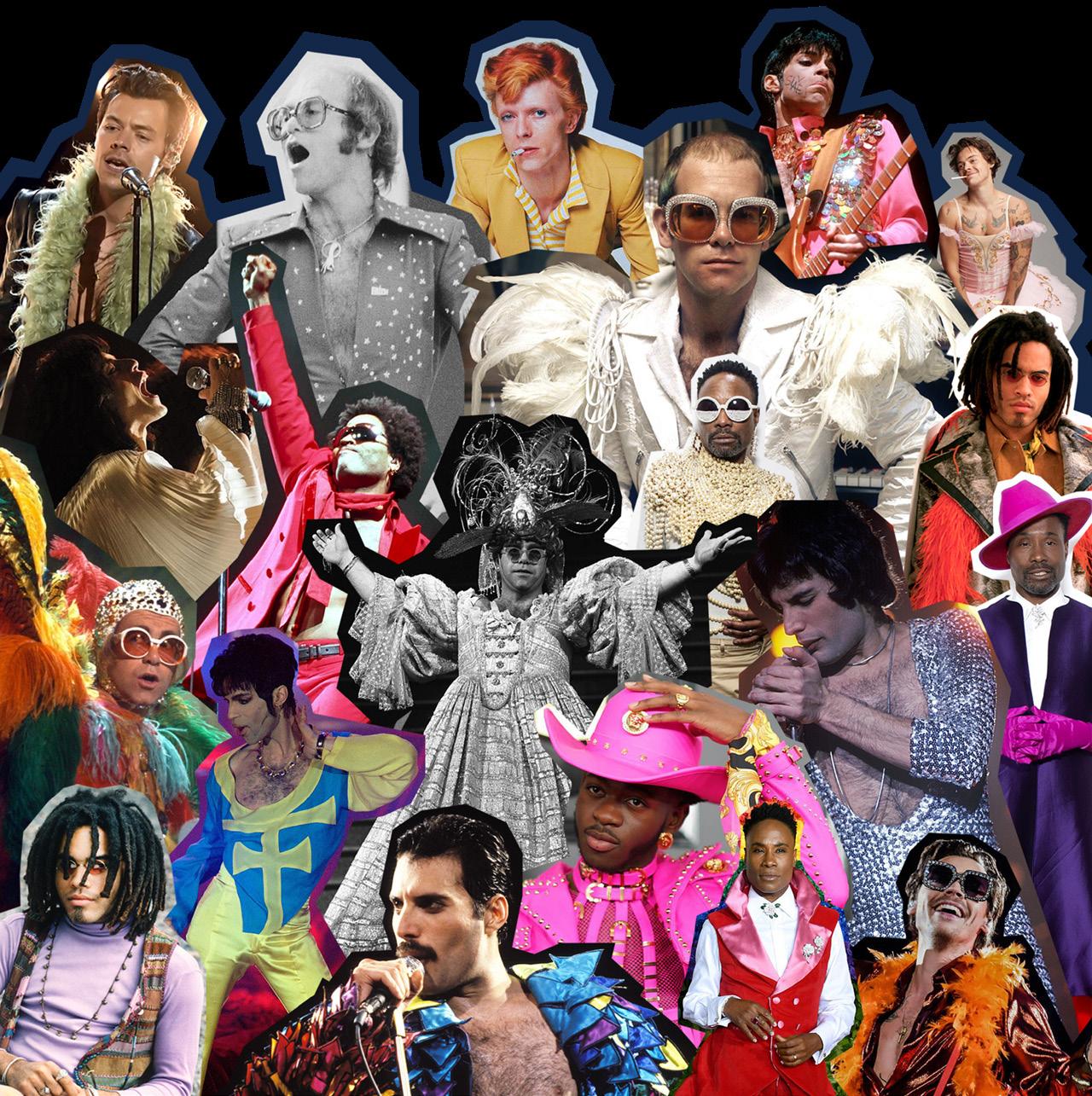
FASHION
DavidBowie was the chameleon of fashion; he changed personas as he changed clothes. Yet, even as his style evolved, he remained himself. Bowie’s legacy marks an important point in the history of men’s fashion, one where men began to explore and expand on the idea of masculinity.
The traditional approach to clothing is gendered, historically sporting the idea that men wear pants while wom en wear dresses and skirts.1 As such, a man who wears “feminine” clothing challenges social norms at their very core. While Bowie was not the first man to challenge these norms, his style caught the attention of millions. Bowie appeared on the cover of his third album, “The Man Who Sold The World,” in a dress by London designer Michael Fish, held together only by two buttons on the chest. The look was an early indication of Bowie’s adoration for pushing the boundaries of gender in fashion.2
Freddie Mercury also had a classic look that redefined masculinity. While he wore tops to expose his hairy chest, embodying the masculine look, he brought in studded accessories as a reference towards BDSM leather cul ture, a gay subculture of the 1980s.3 He also had a love for theatrics, which he expressed through his style. Mer cury posed for Classic Rock Maga zine in 1977, wearing a silver sequin catsuit and mask.4 Men using stylistic elements thought to be feminine was uncommon at the time, especially in the male-dominated industry of rock ‘n’ roll.5
Bowie and Mercury, along with Elton John, Prince and Boy George, paved the way for a newer generation of artists to express themselves openly through their style. Inspired by past style icons, celebrities like Billy Porter, A$AP Rocky, Lenny Kravitz, Lil Nas X and Machine Gun Kelly continue to reinvent masculinity. Notably, Harry Styles has influenced a new genera tion to feel comfortable breaking gen der norms and expressing themselves.
¹ Amy M. Blackstone, “Gender Roles and Society,” Human Ecology: An Encyclopedia of Children, Families, Communities, and Environments, p. 335-338, August 2003.
² Trisha Balster, “Know your Icons: Tracing David Bowie’s Fashion Influence,” Indie, Jan. 10, 2018.
³ Ibid.
⁴ Ibid.
⁵ Christopher R. Martin, “The Naturalized Gender Order Of Rock and Roll,” Journal of Communica tion Inquiry 19, no. 1, p. 53-74, April 1, 1995.
Styles has successfully and effort lessly blurred the lines between fem ininity and masculinity. His signature looks include colorful cardigans and flowing slacks, often paired with pearl necklaces.6 According to Styles, “Any time you’re putting barriers up in your own life, you’re just limiting yourself. There’s so much joy to be had in play ing with clothes.”7
While the idea of masculinity has ex panded, men who wear dresses and break norms are still a minority.8 Ac cording to the hierarchy of credibil ity, members of the highest group define how things are and what rules you should follow. That’s where Styles comes in. In his ten years of interna tional stardom, he has accumulated an influential star power that has granted him the ability to initiate social change.
others had more negative reactions. Conservative political commentator Candance Owens used this cover as an example of why we should “bring back manly men.” It’s easy to get caught up in the criticism, but all of these reac tions—both the good and the bad— demonstrate the extent and power of Styles’ platform. When he steps out, the world observes.
Yet, it’s important to note that Styles’ influence doesn’t stand alone, nor should he be the face of the cause. We must continue acknowledging the broader group of historic influen tial figures who have paved the way for modern gender-breaking icons to take form. Additionally, we must con tinue to acknowledge how some folks who challenge norms are never grant ed the praise Styles is. For example,
Bowie and Mercury, along with Elton John, Prince and Boy George, paved the way for a newer generation of artists to express themselves openly through their style.
Styles broke the internet when he stood on the 2020 December cov er of Vogue in a baby blue ball gown designed by Gucci.9 The photo and accompanying article gained a lot of momentum, but the internet was split in their reactions. While many praised Styles for his history-making moment,
⁶ Mary Dodys, “Deal With It: Harry Styles is one of the Biggest Fashion Influences of Our Time,” Affinity, Nov. 29, 2020.
⁷ Ibid.
⁸ Chris Greer and Eugene McLaughlin, “We Pre dict a Riot?” The British Journal of Criminology, no. 50, p. 1041-1059, July 19, 2010.
⁹ Sara M. Moniuszko, “Harry Styles responds to criticism over ‘Vogue’ cover ballgown,” USA Today, Dec. 2, 2020.
Billy Porter has been breaking norms by wearing dresses far longer than Styles yet was never granted the pres tige of being Vogue’s first solo male cover star. As a cis, white male, Styles still reserves a lot of privilege and his norm-breaking influence shouldn’t be completely separated from that.
Present-day artists have been shaped by influences like Bowie and Mercury, and now they are following suit inspiring us for generations to come that dress ing doesn’t need to look one way. ■
FALL PRINT 2021
Contemporary Art’s Power Trifecta
HOW BASQUIAT, WARHOL AND HARING PERSIST THROUGH THE DECADES
Written by Nina Johnson, Arts Editorial Assistant Graphic by Shea Murphy, Contributing Graphic Artist

ARTS MODA | 8
Art’s
presence as an important and captivating source of power long precedes the entrance of Basquiat, Warhol and Haring, but in the mid20th century, these artists and their genius took hold, enchanting most and inspiring many. The question is, what similar forces drove their influence— whether in Pop Art, neo-expressionism or subway station walls—to grow?
Jean-Michel Basquiat, a New York native who grew up frequenting the Museum of Modern Art, was a gifted student and eventual teen runaway who made his jump into the art world through graffiti under the pseudonym SAMO.1 Starting in Manhattan’s high art districts of Soho and the Lower East Side, his creations were distinct and eclectic. He rejected consumerism, class systems and systemic racism, and conveyed these messages through the language used in his art. Basquiat is also recognized for his elaborate de piction of the body in all of his work.2
His quick rise to fame equated to the cord his art struck: his compounded use of pictograms, poetry and opin ionated phrases created the basis of his unconventionality and eventual adoration. He inspired critical think ing, and didn’t fear making a mess. Even after his tragic death from an overdose at only 27-years-old, he nev er ceased to amaze fans and critics, and his power persisted.
The eldest of the group, Andy Warhol, is a complicated artist, though he re mains a household name next to art ists such as Picasso and Van Gogh. Warhol’s paintings of the banal—which highlighted consumerism of the time— quickly moved to the forefront of the Pop Art movement, and began influ encing the worlds of fashion and film.3
His art was loud and larger than life while his infamously strange persona shocked his observers.
His sublime vision of life is not with out issue: Warhol and his art bring into question whether someone’s power is still valid when aspects of it now seem antiquated, or problematic. For a life as chronicled as Warhol’s, gaps and hy pocrisies in his art have become subject
¹ “Race, Power, Money–the Art of Jean-Michel Basquiat,” The Guardian, Sept. 8, 2017.
² Ibid.
³ The Editors of Encyclopaedia Britannica, “Andy Warhol,” Britannica, updated Aug. 2, 2021.
to criticism. His depiction of women is seen as exploitative and disconcerting, and his anti-consumerist message did not align with his mass-produced art. Warhol’s power feels glib compared to the grandeur it once was; however, his influence is inestimable.4
Haring’s use of the unexpected lay in his strict dualism: discussing the most difficult topics through art that even children were visually drawn to.
Despite these artists’ shared senti ments of anti-consumerism, today their influence and their art gets used
Warhol and his art bring into question whether someone’s power is still valid when aspects of it now seem antiquated, or problematic.
Keith Haring, a fellow graffiti aficio nado, created one of the most distin guishable visual languages in modern culture.5 His short career, beginning and ending in the ‘80s, took over the public sphere unexpectedly. Haring’s style had a fresh feeling, providing a light when morale was low. The sym bols and figures in his art translated into a novel wave of optimism and pos itivity through the use of bold colors and dancers.6
Haring’s messages were clear-cut and poignant, with one infamous piece stating “Ignorance=Fear, Si lence=Death, Fight AIDS, Act Up” in the midst of the then-unspoken AIDS crisis.7 He was refreshing and generous in his work and what appeared to be an unabated desire for good. His pow er arose in the unpredictable nature of bringing culture’s most silenced issues to where they should be: everywhere.
⁴ Ibid.
⁵ “How Keith Haring Used Art for Good,” Tate, accessed Oct. 26, 2021.
⁶ Ibid.
⁷ Ibid.
in ways contradictory to their inten tions. Tiffany & Co., for example, used Basquiat’s imagery in its rebranding despite his known criticism of wealth and consumerism.8 While an artist’s power and prominence are survived by those who are passionate, it requires an air of cautiousness, as well as an understanding that passion and blind consumerism are not the same.
Great art is meant to cover the world with its message—it’s sufficient to say this is something their creators want, too. It’s especially important to be a conscientious consumer today, know ing how often an artist’s message becomes commercialized or miscon strued. Even if that Basquiat backpack you wear around campus may be an act of capitalist enterprise, it can also be an act of passion when you take the time to educate yourself on the life and beliefs of the creator. Once this happens, it truly is the power of the artist persisting.
■
⁸ Rakewell, “A Basquiat at Tiffany’s,” Apollo Mag azine, Sept. 12, 2021.
FALL PRINT 2021
Dancing with my Mother Tongue
HOW I RETURNED TO MY POWER THROUGH CELEBRATING PUNJABI
Written and modeled by Sonakshi Garr, Diversity and Inclusion Co-Director
Photographed by Evelyn Barrios, Guest Photographer
Photo Editing by Audrey O'Neill, Photography Director
Inevery word I spit, my lips repress a violent waltz between two tongues.
The first tongue is wet and knotted— drenched with the hope of authentici ty, but not the promise of it. This first tongue has seen Punjabi many times in her gracefully rugged nature, but has never bothered to say hello. The second tongue is supple—the product of the type of discipline you can only learn in white classrooms and white playgrounds and white parties.
In the United States, 77% of people say that speaking English is important to national identity.1 The mere accent that envelopes someone’s English plays an even greater role than their looks when it comes to perception.2 I ached to be a part of this American identity.
Punjabi is the mother tongue of 146.7 million people across the globe—in cluding my parents.3 It is the language I first heard at home in a small, heavily white Midwestern town, sandwiched between stale cornfields, silent ware houses and savvy people. Punjabi is the language that decorates stained spice packets in my family’s cabinets and playlists on our road trips. It is the language that slips from my parents' lips like honey when they sing and like water when they rant.
And that’s why I hated it. I hated Pun jabi because I was Punjabi.
For me, middle school gym class was a sweaty, concave mirror, reflecting rem nants of my distinct culture through pitch-black splintered hair ties and missed kicks on overgrown soccer
¹ “Punjabi - Worldwide Distribution,” WorldData, accessed Oct. 23, 2021.
² Bruce Stokes, “Language: The Cornerstone of National Identity,” Pew Research Center, May 30, 2020.
³
fields. In high school, I hated how my Punjabi bled everywhere, so I stopped speaking the language altogether.
Growing up in a town with a popula tion that was 2% Asian, language was one of the only factors of my identi ty I felt I could control. If I could not control how the aromas of my school lunch filled the air, I could control the way my tongue curled to match the in terests of my peers.
These emotions shifted when my grandfather, a stern man with caramel skin and elegant opinions, suddenly died the day of my junior prom. His death reminded me of all the things I had killed before—tethered relation ships, old versions of myself and most importantly, the mother tongue that could have made us closer.
In a 2017 study done by linguists, it was discovered that people never truly for get their first language—it just needs to be revived.4
So at 19, I chose to revive my wound ed mother tongue by threading ran dom Punjabi words into the sentences I spoke with my parents. The words came out bruised, draping the coat of a Midwestern accent. I could not roll my “R”s or annunciate my “D”s, but the daily attempts, while clumsy, made me feel like I was coming home to myself.
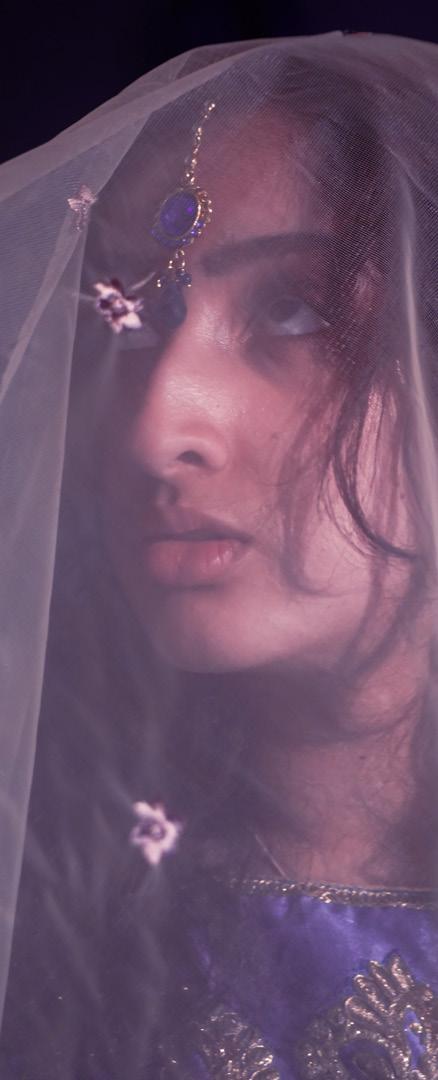
I knitted old Punjabi songs into the playlists I listened to when I ran er rands and brushed my teeth. I adorned henna on my palms. I cooked lentils in beds of softened onion and tomato. I stopped catering to the white gaze.
Punjabi culture is loud in every aspect of the term—it tells the stories you could only ever tell in India, where hundreds of small revolutions sit in every street corner. Layered hand drums and jars of saffron and old, intricate folktales all taught me the meaning of multidimen sionality, the meaning of coexisting.
On a campus that so badly longs to lim it its members to one identity, untan gling my mother tongue was not only a way of returning to my authenticity, it was a way to join the narrative of other students on the same journey. By em bracing my ethnic language, I found I was engaged in my own activism: be ing an unapologetic version of myself.
⁴
“Psychologists Show How Accent Shapes Our Perception of a Person,” ScienceDaily, Dec. 20, 2010.
Aamna Mohdin, “Even If You’ve Forgotten the Language You Spoke as a Child, It Still Stays with You,” Quartz, Dec. 18, 2017.
MODA | 10
■
CULTURE
,SEx dru s And rock & roll
GLAM ROCK'S IMPACT ON THE '70S AND '80S
 Written by Rachel Hale, Culture Editor
Photographed by Molly Jacobs, Staff Photographer
Modeled by Rachel Hale and Austen Wallenfang Makeup by Riley August, Makeup Director
Written by Rachel Hale, Culture Editor
Photographed by Molly Jacobs, Staff Photographer
Modeled by Rachel Hale and Austen Wallenfang Makeup by Riley August, Makeup Director
Platformboots, outrageous hair and cocaine galore: It was the 1970s, and dreamy psychedelic sound had given way to a louder, more ostentatious celebration of celebrity culture, style and music. Sandwiched between the catchy bubblegum pop of the late ‘60s and rocker hair metal of the ‘80s came punk’s flamboyant younger sibling: glam rock. Highlighted by stars like David Bowie and Marc Bolan, the rockand-roll subgenre came to represent an era of music that pushed gender norms, embraced the avant-garde and brought performance back to the forefront of the arts scene.
As was true of the boy band hysteria of the ‘60s, America has its neighbor from across the Atlantic to thank for glam rock. Originating on the British pub scene, glam rock cut through much of the heavily politicized music of the ‘60s to return to simpler, ‘50s inspired lyrics and aggressive chords. Musically, the sound was dominated by heavy guitar and shaped by hardrock and pop.1 In a subsequent coun terculture of their own, glam rock ers were, as English musician Robert Palmer put it, “rebelling against the rebellion.”2 The genre fought against rock ideology insisting a musician’s persona and music must be one-andthe-same, embracing a hyperbole of performance so outlandish that it challenged the music itself.
Though Bowie is perhaps glam rock’s most well-known artist, his teenage friend, Bolan of T-Rex, is largely credit ed with ushering in the movement’s or igins. Forming T-Rex in 1967 England, Bolan’s signature curls, pink feather boas and androgynous satin silver ¹ The Editors of Encyclopaedia Britannica, “Glam rock,” Britannica, Nov. 28, 2013. ² Ibid.
ARTS
FALL PRINT 2021
suits created a “T. Rextasy” among fans not unlike the Beatlemania that came before it, and glam rock cement ed its electric sound in initial albums like 1971’s “Electric Warrior” and 1972’s “The Slider.”3 Bolan’s raunchy guitar riffs put glitter rock on the map, but it was Bowie’s Ziggy Stardust perso na that broke the American music wall and cemented glam rock into history. Based on a bisexual rock star from an other planet, Stardust, Bowie’s “pro jection of a doomed messianic rock star”4 portrayed a gender-fluid alien that succumbs to the allure of fame, promoting an image of decadence and camp aesthetic. Bowie’s “The Rise and Fall of Ziggy Stardust and the Spiders from Mars” and subsequent sold-out tour launched the orange-haired per former to one of the most lucrative ca reers in music history, signaling a new era of rock in the process.
Rocker Alice Cooper once aptly de scribed this shift: “We were into fun, sex, death and money when everybody was into peace and love. We wanted to see what was next. It turned out we were next, and we drove a stake through the heart of the Love Generation.”5
In the years that followed, bands uti lized elements of glam rock in com bination with subsequent movements like hard rock, disco and early punk. Slade used elements of glam rock’s simple chords in songs like “Cum on Feel the Noize,” Roxy Music bridged the gap between glam and punk with new wave technology, and Gary Glit ter pushed the glam rock image to the extreme with glitter suits and platform shoes. Though the genre was primarily a British phenomenon, The New York Dolls and Cooper brought more vio lent, gritter styles of glam to America, and hits from British Elton John’s 1973 “Goodbye Yellow Brick Road”’ topped charts in both countries. The glam rock movement of the ‘70s became catego rized by a style that “emphasized the sartorial overkill of psychedelia, while strongly de-emphasizing the intellec tual content of popular music.”6
³ Editors Rolling Stone, “T.Rex,” The New Rolling Stone Encyclopedia of Rock & Roll, p. 1003, 1995.
⁴ Ibid, p. 106.
⁵ Maxim W. Furek, “The Death Proclamation of Generation X: A Self-Fulfilling Prophesy of Goth,” Bloomington, p. 62, 2008.
⁶ David Heslam et al., “The Rock 'n' Roll Years,” New York Crescent Books, p. 206, 1990.

MODA | 12
At the end of the ‘70s, a heavier vari ant of glam rock combined with ele ments of Britain’s underground punk scene to shape the era of heavy face makeup and guitar solos traditionally associated with rock music today, also known as “glam metal” or “hair metal.”
Pioneered by bands like Motlëy Cruë, Quiet Riot, Twisted Sister, Poison, Def Leppard, KISS, Skid Row, Bon Jovi, Guns N’ Roses, Whitesnake and War rant, glam metal produced some of rock’s most infamous anthems, from “Pour Some Sugar on Me” to “Lick it Up.” Even as these bands sought to move their sounds toward hard rock and heavy metal, glam rock’s style and performance persona cemented its long-term role on the rock scene in performers’ leather pants, violent stage antics and crass lyrics.
Bands like Maryland’s Kix and San Francisco’s Night Ranger popularized glam metal in the U.S., and a club scene grew on the Sunset Strip in Los Ange les. Glam metal performers’ infamous lifestyles of excessive partying, strip pers and drugs made for tabloid press and MTV coverage that also helped make rock more mainstream. Even classic heavy metal acts like Ozzy Os bourne and Judas Priest incorporated glam metal elements into their perfor mances, and Bon Jovi’s 1986 “Slippery When Wet” saw three top 10 singles, skyrocketing the genre’s popularity and widening its audience to women.
By the mid-‘80s, glam metal achieved mainstream recognition, riding a wave of commercial success all the way until Nirvana’s grunge boom of the ‘90s.
Despite its influence, glam rock is often glossed over in rock and roll chronolo gies, referred to in fleeting paragraphs as the predecessor to punk. Scholars have categorized the genre’s fashion as “offensive, commercial and cultur al emasculation,”7 reinforcing the idea that rock should be masculine, while others have referred to its sound as disparage, meaningless music. Yet the genre’s saving grace was its own self-awareness, profiting off largerthan-life imagery while knowing it was only possible to exist in a rose-colored version of reality in the moments of its own creation. Glam rock was mon umental in its evolution of modern sound, and ultimately, in saving the rock genre itself. The 1970s saw rock’s ⁷ Georgina Gregory, “Masculinity, Sexuality and the Visual Culture of Glam Rock,” University of Central Lancashire, p. 37, Jan. 1, 2002.


dance with death following a series of tragedies in the rock world, including deaths of visionaries like Jimi Hen drix, Janis Joplin, Jim Morrison, Brian Jones and Bolan himself. The Beatles broke up, Mick Jagger turned the Roll ing Stones commercial and concerts became violent as rock and roll elites grew more removed from the reali ties of everyday life.8 The palatable glam rock that followed bridged the gap between rock and easy listening, and the outlandish permed hair, live snakes and glaring strobe lights of its concerts commanded fans’ attention. In this way, music returned to its roots as a form of escapism, making cos tume and persona as central to glam rockers’ music as their lyrics. Glam’s brazen embrace of fame, ego and dec adence saw the rise of some of rock’s peak performers, from Bowie to Fred die Mercury to Prince, all of whom kept audiences listening to rock.
Perhaps more important is glam rock’s monumental role in forcing the music world to consider the expression of sex uality and gender. In a genre dominated by testosterone, glam rockers created a version of masculinity that left room for feminine expression, combining ele ments of 1930s Hollywood glamour and 1950s sex appeal with new-age futuris tic and spacey garments. Performers who were out like Bowie, Mercury and John allowed LGBTQ+ youth to find a male identity in rock, and the music scene saw an embrace of LGBTQ+ is sues and women’s liberation.
Glam rock highlighted a transitional era of rock with its zest for life and em brace of persona, and its legacy lives on in the way it challenged gender norms and the music status quo. An drogynous fashion and cross-dressing set the stage for the style of artists like Harry Styles and A$AP Rocky, and mu sicians like Lady Gaga and Miley Cyrus have embraced glam-like personas on worldwide stages. Genres like alterna tive rock and punk take lyric and chord cues from glam, and stars from the era inspired the careers of countless cur rent performers. Despite its brevity, glam rock’s legacy transcends gender, genres and generations, and it should be remembered for the way it forever altered the path of music history.
■
⁸ Philippe Paraire, “50 Years of Rock Music,” Edin burg, p. 122, 1992.
FALL PRINT 2021
Through Lands and Slams
THE FEMME AND QUEER SKATE COMMUNITY OF MADISON
Written by Tessa Devine, Lifestyle Staff Writer Photographed by Hunter Kiehl, Staff Photographer
Modeled by Timothea Stinnet, Winnie Bishop and Brenna Paul
“One of my favorite things about skating is that it feels like rebellion, it feels like breaking norms,” said 20-year-old skateboarder Nina Cicero-Soles. “I get to do something that girls aren’t typically encouraged to do and I feel badass doing it.”
Nina is one of many skaters that gath er on Wednesday evenings at Good man Skatepark. Originally started in 2014 as Lady Skate Night, this weekly informal event has evolved into what is now known as Femme and Queer Skate Night.

“A bunch of Madison femme present ing and/or queer skaters get together to skate in a non-judgmental environ ment,” explained 18-year-old attendee Winnie Bishop.
Skating is for everyone, but that doesn’t change the fact that skateboarding has traditionally been a male-domi
nated sport—or that the skatepark can be an intense environment to learn in. Skaters fly down ramps and ride through obstacles; wheels slam loud ly against the concrete and the pop of board tails echo through the park; and exclamations of joy, frustration and encouragement all blend into a rowdy ambiance. To a beginner, the park may look and feel chaotic. There is a unique and beautiful flow to every park—but it takes some getting used to. Femme and Queer Skate Night is the perfect place to learn.
Through all the lands and slams, par ticipants are encouraged to express themselves on skate night, whether it’s through skating, falling or even just connecting with new people. These skate nights aren’t official, organized events, but rather, an organic experi ence. The number of people that at tend can look different week to week, but one thing always remains the same: inclusive skating.
Representation in any environment is important, and it is exceptionally ben eficial to learn something new among people who you relate to and who in spire you—skating is no exception.
“Having queer and female representa tion is incredibly important,” said local Madison skater, Leon C. “If you nev
Through all the lands and slams, participants are encouraged to express themselves on skate night, whether it’s through skating, falling or even just connecting with new people.
MODA | 14
LIFESTYLE
er see someone like you doing some thing, it doesn’t seem possible. But once you see it, you can be inspired.”
Winnie echos this idea by recalling what it was like when she first start ed skating.
“Learning was intimidating at first, especially since skateboarding is so male-dominated, but having other girls and gays to skate with helped me stick with it.”
Getting to the park may seem like the hardest part of your skate journey. In reality, continuing to skate and getting back up when you fall down is the real challenge. This is why it’s vital to have a dependable community to help you back up when you (inevitably) eat shit.
Everyone should be given the oppor tunity to shred, no matter what you look like or how you identify. The lo cal skating community is one that has made great strides over the years, and today, you can always expect to find great femme and queer skaters at the park on skate night.
“Skateboarding as a femme or a queer person, or entering any community as an outsider, starts with you,” says Cice ro-Soles. “It starts with you being con fident, being who you are and knowing you don’t need to be incredible to be able to show up there.”
Feeling ready to shred? Grab a board and stop by Goodman Skatepark from 6-8 p.m. on Wednesday nights or fol low its Instagram @femmeandqueer skaenight. And if you’re still feeling hesitant to jump in, just remember that skateboarding should be about you and your progress first and foremost, not about anyone else.

Interviewees: Nina Cicero-Soles
Leon C.
Winnie Bishop ■
FALL PRINT 2021
,
CULTS, CONSPIRACIES AND CORRUPTION
THE RISE AND EVOLUTION OF THE AMERICAN CULT MENTALITY
Writing and graphic by Arella Warren, Deputy Editor
Themid to late 20th century was a time of historic and political turmoil in America. The 1945 victory of World War II was followed by domestic issues, renewing a sense of helplessness across the nation. At the same time, the ‘60s and ‘70s saw an increased interest in space and religion as a result of new technologies and media. With the rise of New Religious Movements and the massive expansion of media and news information, people were desperate for something to believe in, and the cult mentality quickly gained traction throughout various communities.
A cult is formally defined as “a sys tem of religious beliefs and practices.”1 People tend to make a hard distinction between cults, often likened to New Religious Movements or NRMs, and re ligion, which is held in higher esteem. In reality, the line between cults, NRMs and religions is blurry—and each of these categories have seen their share of abuse and corruption.
Like religion, cults and NRMs gener ally venerate a saintly leader or God and preach stories about the end of the world and ways to attain spiritual enlightenment.2 Most world religions, however, follow set moral systems that have existed for hundreds, if not thousands, of years, whereas cults and NRMs tend to be more sensational and less sustainable.
American journalist Tom Bissell ex plains, “At its core, the only difference between a cult and a religion is antiq uity. But antiquity amounts to a lot. Among other things, it allows follow ers to live and believe within the pa rameters of a complex intellectual tra ¹ “Definition of Cult,” Oxford Learner’s Dictionar ies.
² Tina Rodia, “Is it a cult, or a new religious move ment?” Penn Today, Aug. 29, 2019.

dition. A human claiming to be God, and making concomitant demands of his or her community, falls into a much simpler intellectual tradition: the cult of personality.”3
This cult of personality that Bissell re fers to, in which a figure is upheld as in fallible, is what sets dedicated cult fol lowings apart from organized religion. Likewise, German sociologist Max We ber suggested that an effective leader relies on and creates a form of charis matic authority in which they position themselves as a savior deserving of in stitutionalization—the exact leadership for which many Americans of the ‘60s were searching.4
This charismatic appeal is easily ex emplified by one of the world’s most sensationalized cult followings: The Manson Family.5 Charles Manson is infamous for inspiring complete de votion in his “Manson Girls,” a group of young-adult female followers who lived communally and worshiped the psychedelic teachings and erratic be haviors of Manson. At the end of the ‘60s, Manson was sentenced for com mitting nine murders, and the girls were suspected of many more, plung ing the media into a state of terror and paranoia for months.6
The ‘70s saw the rise of notorious Jim Jones, who directed his followers down a similarly dark path. Jones first opened the Peoples Temple church in the ‘50s as a charitable place of wor ship committed to racial and economic equity.7 Jones’ popularity soared from
³ Tom Bissell, “How Cults Made America,” The New Yorker, April 24, 2019.
⁴ Jonathan Bastian, “How ‘60s and ‘70s America gave rise to cult leaders,” KCRW, Aug. 21, 2021.
⁵ Fortesa Latifi, “Most Famous Cults in U.S. Histo ry,” Teen Vogue, Aug. 30, 2021.
⁶ Ibid.
⁷ “Jonestown,” History, Nov. 20, 2019.
there, and in 1977, he persuaded near ly a thousand of his congregants to move to a settlement in Guyana called Jonestown. On the settlement, Jones became paranoid, convincing his fol lowers to drink fruit juice mixed with cyanide in a ritual mass-suicide, leav ing 900 dead.8 Just two years after the move to the settlement, the Jonestown Massacre went down in history as one of the largest non-natural losses of U.S. lives, sparking the morbid phrase “drinking the kool-aid.”9
Meanwhile, in Colorado, Marshall Ap plewhite and Bonnie Lu Nettles were slowly growing their following for Heaven’s Gate, a NRM preaching that extraterrestrial spacecraft would soon come to Earth to take the faithful to the kingdom of heaven.10 Applewhite con vinced the community that their bod ies were merely vessels holding them back from a higher form of spiritual existence. In 1997, with the arrival of the Hale-Bopp comet, 39 members— dressed in matching black uniforms complete with Nike shoes to represent unity—drank a lethal potion in hopes of transcending their physical existence.11
The Manson Family murders and ritu alistic suicides of the Peoples Temple and Heaven’s Gate live on as a few of the country’s most startling cult sto ries. Given their tragic outcomes, it’s easy to see how these instances gained notoriety, but it’s harder to understand how leaders come to hold such power and why people willingly follow erratic and harmful demands.
American psychoanalyst Daniel Shaw proposes that the real power of a cult lies in its mentality, whereby “Cult mem
Ibid.
Ibid.
“Heaven’s Gate cult members found dead,” History, Feb. 9, 2010.
Ibid
⁸
⁹
10
11
CULTURE
bers” actually come to embrace and even glorify these kinds of mistreat ment in part because their leaders, and their followers by proxy, have mastered the art of seduction, using techniques of undue influence.”12 Cult leaders—in tentionally or not—prey on the anxiet ies, insecurities, traumas and need for acceptance that all humans share.
Manson, Jones and Applewhite were able to organize devoted followings, convincing innocent individuals to take drastic measures, in large part due to their charismatic, larger-than-life per sonalities that drew people to them, isolating their devotees from the rest of society like a toxic relationship. Man son and Jones were known to employ “love bombing,” in which they’d lavish new members with love and attention in order to gain their trust, making ma nipulation and mind-control flow nat urally over time.13 Additionally, cults effectively draw on our psychological, in-group out-group biases, building an us versus them mentality, something that continues to threaten modern so ciety today, facilitating racial, gender, sexual and other biases.14
Still, not every cult aims to manipulate or isolate. Sometimes, one’s power lies in the simple appeal to a commu nity, especially as it pertains to social and spiritual needs. Claude “Raël” Vo
12 Daniel Shaw, “Traumatic Abuse in Cults,” Spiri tual Abuse Resources.
13 Mark D. Griffiths, “Love Bombing,” Psychology Today, Feb. 14, 2019.
14 “10 Things to Know About the Psychology of Cults,” Online Psychology Degree.
rilhon founded Raëlism in the ‘70s on the view that humans spawned from an alien race known as the Elohim, who Raël prophesied will one day re turn to grant us intellectual prowess, free love and sexual liberation.15 As one of the largest UFO cults in history, Raelism remains a prominent New Re ligious Movement to this day, estimat ed to have over 100,000 followers.16

While Raelism has proven relatively harmless in its intentions and effects, and its followers lead typical lives, they’re nonetheless convinced that the extraterrestrial Elohim are gods and worship the teachings of Raël as dogma. This begs the question: Is any form of belief that encourages people to reject reasoning for cult-like teach ings and dogma truly harmless?
NRMs and UFO conspiracy theories boomed in the ‘70s and ‘80s when peo ple first gained access to the internet— today, the web has become an even more potent and foreboding breeding ground for niche cultures that facilitate in-group biases and give way to echo chambers of conspiracy theory.17 Most recently, perhaps, is the spread of QA non, a modern-day cult that managed to draw in hundreds of thousands of supporters during what they claim is the nation’s first so-called internet elec tion. Taken as isolated incidents, these events are easy to brush off as “fan theories,” but social media is far from
15 Ibid.
16 Stephanie Buck, “In this bizarre religion,” Time line, Oct. 24, 2017.
17 Don Knapp, “The Internet as a god,” CNN.
an isolated system—it has a major in fluence on the world that is only be coming more prevalent as illicit content continues to go largely unmoderated.
Today, misinformation and fake news dominate, spreading six times faster than true information, and people are more likely to accept fake information online than the truth.18 This is, of course, disturbing, as new media promotes the rapid spread of what might otherwise be considered nonsensical narratives— but it’s also rooted in a much larger ethical concern that has been brewing since the ‘70s around the lack of digi tal regulation. Social media platforms have created a massive echo chamber that allows for conspiracy theorizing and the cult mentality to thrive, yet no one is taking responsibility for this well of corrupted power.
The human propensity for subscribing to the cult mentality is, in part, deriva tive of our need to belong. But we as a collective need to take more account ability in our abilities and motivation to discern between a legitimate nar rative and an unwarranted conspiracy theory or dogmatic rambling. Alterna tively, we risk falling victim to a state of global, cult-minded chaos fueled by fantasy and misinformation, blur ring the lines between fact and fiction to the point that the truth becomes entirely unattainable with the rise of digital information.
■
18 Peter Dizikes, “Study: On Twitter, false news travels faster than true stories,” MIT News, March 8, 2018.
FALL PRINT 2021
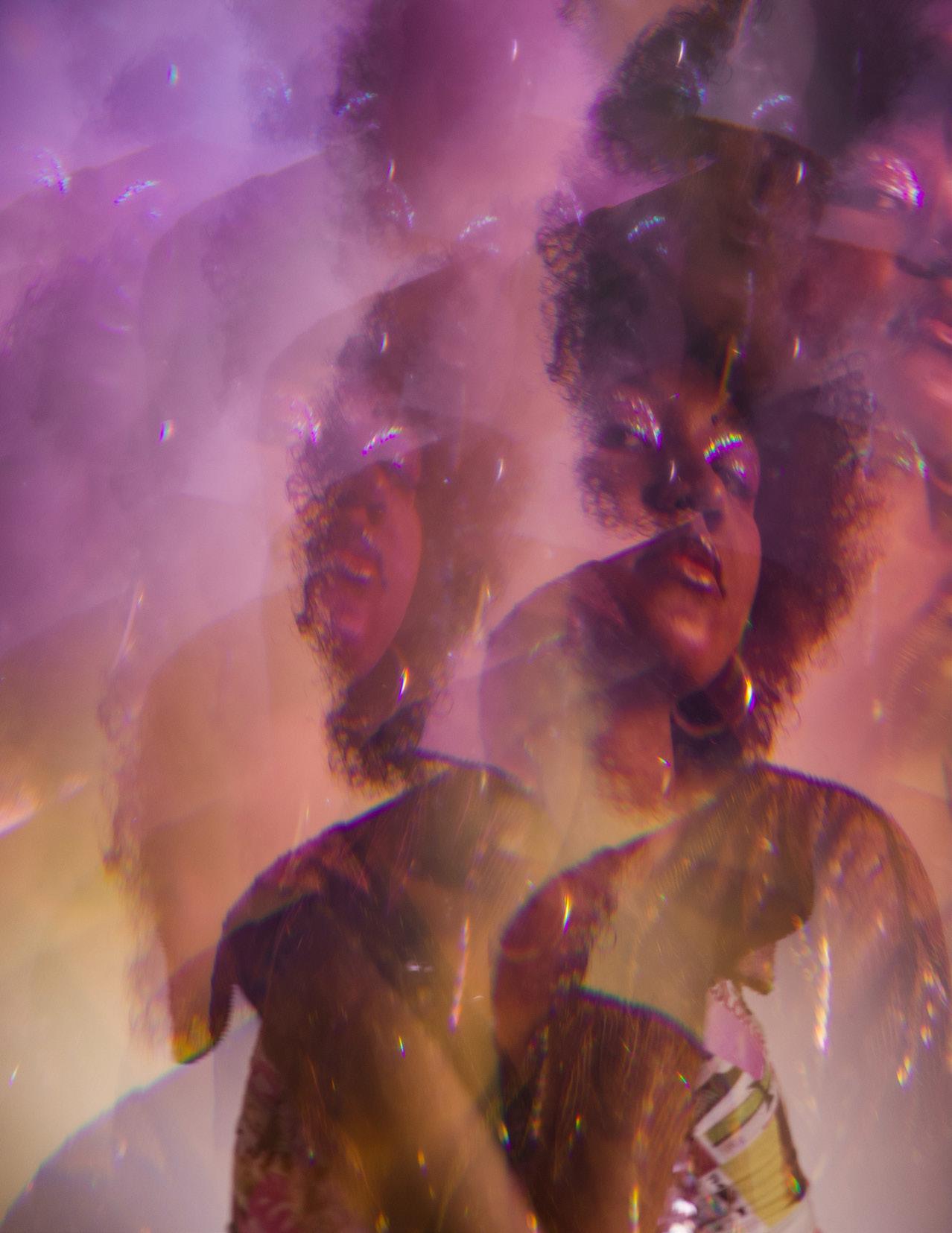 Directed by Corbin Woessner, Fashion Director, Erin Galiato, Staff Fashion Member, and Dani Arensdorf, Fashion Contributor Photographed by Audrey O'Neill, Photography Director, and Hannah Huber, Staff Photographer
Editing Assistance by Seth DeGier, Assistant Photography Director Modeled by Robbi Varona Makeup by Riley August, Makeup Director
Pants made by Dani Arensdorf, Fashion Contributor Special thanks to Alex Kiander, @alexkiander
Directed by Corbin Woessner, Fashion Director, Erin Galiato, Staff Fashion Member, and Dani Arensdorf, Fashion Contributor Photographed by Audrey O'Neill, Photography Director, and Hannah Huber, Staff Photographer
Editing Assistance by Seth DeGier, Assistant Photography Director Modeled by Robbi Varona Makeup by Riley August, Makeup Director
Pants made by Dani Arensdorf, Fashion Contributor Special thanks to Alex Kiander, @alexkiander

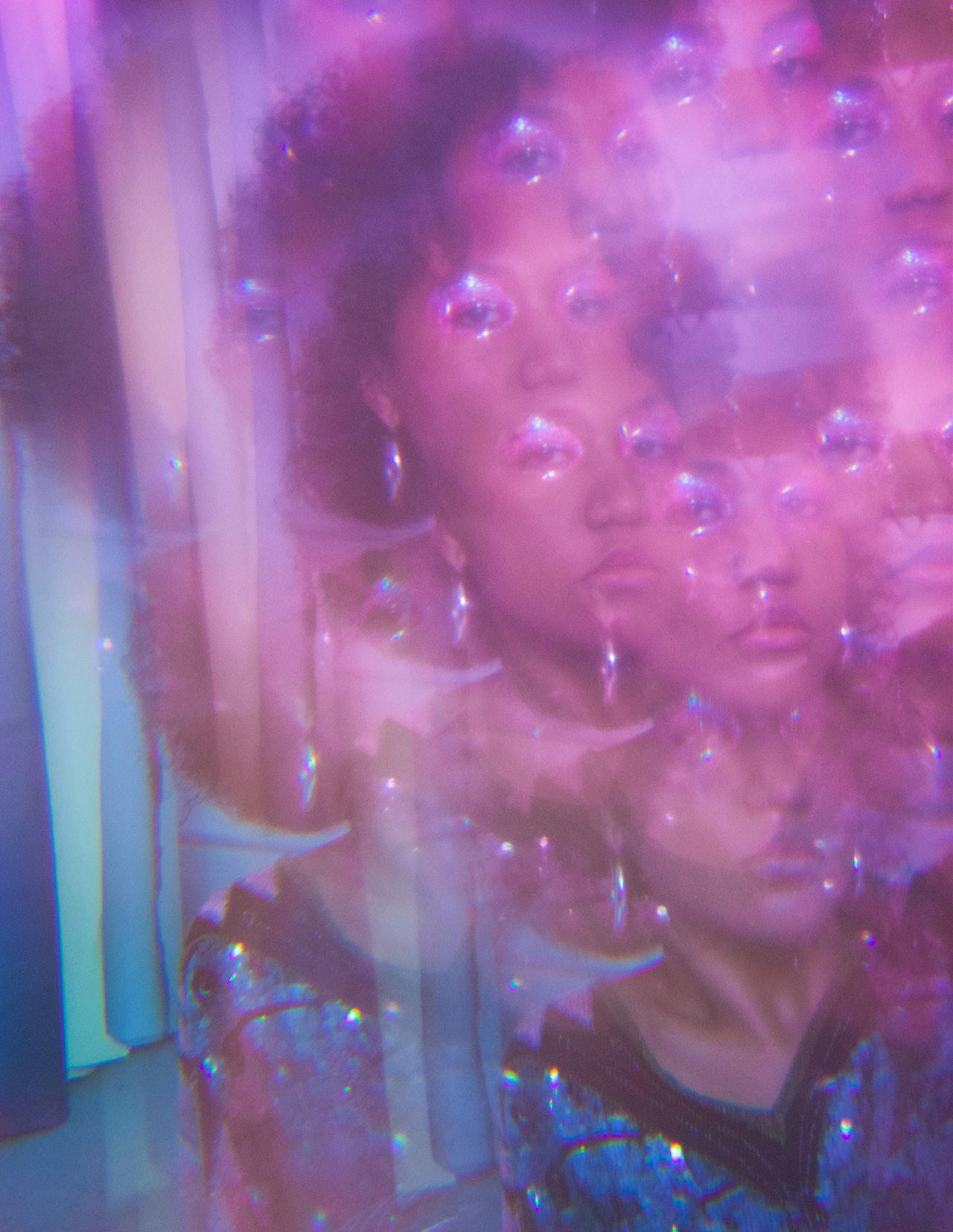

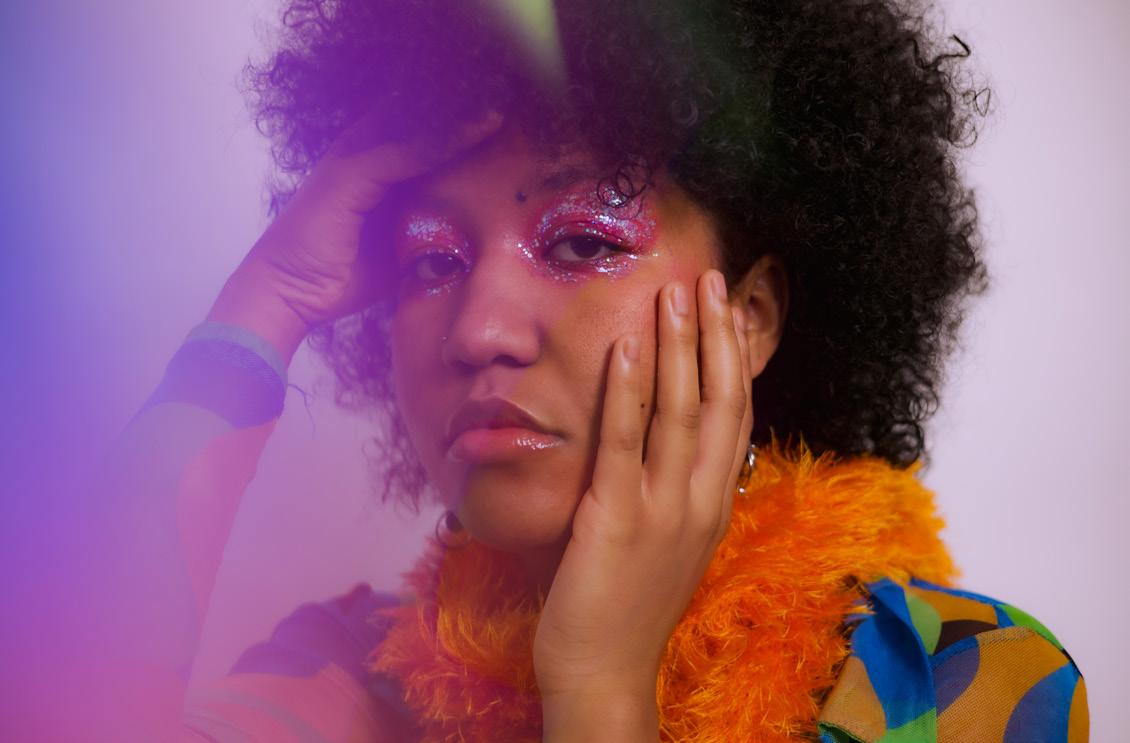


Lessons from My High School Speech Coach
FIVE TIPS TO IMPROVE YOUR PUBLIC SPEAKING SKILLS
Written by Mason Braasch, Lifestyle Editor
Graphic by Alexa Kantor, Staff Graphic Artist
Anyonewho knew me in high school would classify me as a speech kid, belonging to the group of students who dressed up in business suits on the weekend and thought that attending public speaking competitions was a fun pastime. Although I spent the majority of my weekends giving tenminute speeches to audiences of up to 1,000 people, I still get anxious when I have to give a presentation in class.
The reality is, public speaking is scary. In fact, 75% of people actually list it above death when asked about their greatest fear.1 However, public speak ing is an essential component in many aspects of life—whether you’re pre senting an international Ted Talk or giving a speech in class, at some point, you will have to face your fear.
While there is nothing my nationally recognized, high school speech coach could do to entirely subdue my anxi ety around public speaking, these five lessons of his allowed me to overcome the nervousness and become a seem ingly confident public speaker.
1. Prepare with a Power Pose

Every weekend before I gave my speech, my coach instructed me to stand in a power pose with my chest puffed out, my chin held high and my hands on my hips. This “Wonder Wom an” pose might have made me look crazy to those walking by, but it did wonders to boost my confidence.2 The practice of power posing, or standing in a high-power stance for two min utes, is proven to change the way you feel.3 Standing in a powerful pose in the bathroom or hallway for two min utes before you present can enliven you, easing some of the anxiety before you speak.
2. “The Scan”
It’s normal to want to jump into your speech the second you have the floor
¹ Pat Ladouceur, “What We Fear More than Death,” MentalHelp.net, accessed Oct. 2021.
² Amy Cuddy, “Your Body Language May Shape Who You Are,” TEDTalk, June 2012.
³ Kim Elsesser, “Power Posing Is Back: Amy Cuddy Successfully Refutes Criticism,” Forbes, April 4, 2018.
in order to get it over with. Instead, try implementing “The Scan.” Before speaking, take a second to look over your audience, holding eye contact for several moments. Not only will this give you a chance to take a deep breath, but it will signal that you are confident and in control.
3. Never Say Sorry
Tripping over words and forgetting what you’re supposed to say is a com pletely normal occurrence in public speaking, especially when you are nervous. However, my coach fervently insisted that I should never apologize to my audience. Your listeners do not have a script in front of them, and more often than not, they will not know if you have made a mistake. Rather than admit a mistake by apologizing, take a moment to collect your thoughts and then continue on.
4. Be aware of “Penguin Hands”
When we are nervous, our hands and bodies tend to fidget in ways that we may not be aware of. Common nervous habits include picking at your clothes, swaying back and forth or gesturing unintentionally with your hands by your thighs—my speech coach called this “Penguins Hands,” and worked with me for years to break the hab it. While natural, these behaviors un dermine your authority when you are speaking.4 Practicing your presenta tion in the mirror and being intentional about nonverbal gestures and move ment will not only make you seem well-rehearsed, but confident and ca pable as well.
5. Give yourself some grace
No matter how much you prac tice, public speaking is difficult and nerve-racking—but it is also something that you can feel proud of accomplish ing. Whether you are delivering your speech to one person or to 1,000, your ability to convey messages is import ant and worthy of praise. After all, 75% of people would rather die than do what you are doing!5
■
⁴ CareySue Vega, “Manner Monday: Nervous Gestures,” Workology, July 15, 2013.
⁵ Pat Ladouceur, “What We Fear More than Death,” MentalHelp.net, accessed Oct. 2021.
FALL PRINT 2021
LIFESTYLE
Video Killed the Radio Star
HOW MTV REVOLUTIONIZED THE ENTERTAINMENT INDUSTRY AND POP CULTURE
Written by Alexandra Mack, Online Editorial Assistant
Illustrated by Mac Gale, Staff Graphic Artist
Theyear is 1981. School is still a month away and you’ve outgrown your parentmandated bedtime. You’re sitting in front of the TV late at night, nonchalantly clicking through the channels on your brand-new cable box, when out of the corner of your eye, you see the clock change to midnight. You switch channels to see a man on the moon standing beside a flag— the whole screen flashes suddenly in vibrant colors, boldly displaying the letters "MTV". A mission controller speaks up, uttering words that would ultimately pave the way for a pop culture juggernaut to revolutionize the entertainment industry: “Ladies and gentlemen, rock and roll.”
MTV, short for Music Television, made its debut on the small screen on Au gust 1, 1981, kicking off the 24-hour music channel with the Buggles’ “Vid eo Killed the Radio Star.” This would prove to be a prophetic song choice within just a few years.
MTV was a cultural and commercial experiment; although music videos existed in some capacity prior to the
creation of MTV, the term “music vid eo” was virtually unheard of. The idea of a channel purely dedicated to airing music 24-hours a day didn’t appear profitable at the time, so many larg er markets were hesitant to add the channel to their lineups, while record companies were doubtful about pro ducing music videos for it. However, MTV paralleled the emergence of cable TV itself, and traditional broadcast net works began to face challenges with increased options for consumers. This is where MTV’s unorthodox, ground breaking persona began to take shape, helping to bridge the gap between the music and film industries.1
Shortly after, MTV was picked up in ev ery state, and what was once an op tion for musicians to create music vid eos became an expectation. As more households obtained access to cable and the channel became widely avail able, record sales boomed for featured artists and millions of dollars were spent on the production of commod ified music videos. Every trend in the
¹ Adam Behr, “40 Years of MTV: the channel that shaped popular culture as we know it,” Salon,
‘80s that was considered cool could be traced back to the phenomenon that was MTV.2


For much of the 1980s and ‘90s, MTV was a crucial determinant in the fate of an artist’s success, determining who rose to the top and who lagged behind. Artists that had their videos in rotation on MTV saw a spike in re cord sales, and the music video itself evolved into a vehicle through which the limits of creativity were surpassed and advances in technology were am plified.3 At the same time, the visual aspect of music increasingly became more significant, and the artists that recognized this significance were the ones who found the most success.
Michael Jackson was a pioneer in in tersecting music and film, taking the concept of the music video to an en tirely new level with the release of “Thriller.” The 13-minute cinematic
² Cameron Williams, “How MTV changed the world with its industry of cool,” SBS, Feb. 13, 2017.
³ Kansas State University, “Music Experts Share How MTV Killed The Radio Star And Changed Culture Forever 30 Years After Launch,” News wise, June 21, 2011.
MODA | 24 ARTS
work became a cultural sensation; it was a spectacle that had people zom bie-dancing every Halloween for the next 38 years, setting a precedent for the standards of music video produc tion and certifying Jackson as a solo artist. His success opened doors for new artists such as Madonna—whose second album was able to dominate the charts due to the heavy rotation of “Like A Virgin” on MTV, challenging others to respond with their own mov ie-like videos, such as Prince’s “Pur ple Rain.” These musicians, amongst others, were pivotal in turning MTV’s purely rock-oriented origins into a more musically diverse platform.
MTV’s exponential increase in viewer ship and its ability to churn out mega stars like clockwork soon turned it into a commodity that had big-name net works drooling over the possibility of adding the channel to their lineups. In 1985, media conglomerate Viacom pur chased MTV for $667.5 million, taking on exclusive ownership of the channel. This business deal contradicted the channel’s rebellious persona and signi fied the end of an era.
The 24-hour stream of musical content was abandoned with this new owner ship, replaced by blocks of music vid eos that were bundled by genre to fit a more traditional television format. Original television programming also started to be implemented into the channel’s daily lineup in the form of re ality shows, talk shows and cartoons.
In its early days of voyaging into tele vision programming, much of MTV’s content was still related to music. The most influential of all of these musical series is undoubtedly “Total Request Live.” Total Request Live, popularly dubbed “TRL,” debuted in 1998 and quickly became an imperative mar keting tool for celebrities. Counting down the top 10 music videos of the day, TRL was the reason that many of the most popular musical acts of the late 1990s and early 2000s blew up. From punk performers and grun ge groups to pop princesses and boy bands, the show helped a wide variety


of turn-of-the-millennium musicians reach their commercial peaks.
Another outlet that gave artists the opportunity to make their presence known is the MTV Video Music Awards or VMAs. The VMAs is MTV’s annual awards show that premiered in 1984 and remains one of the most-watched awards shows today. The VMAs are about celebrating the best music vid eos of the year, bringing the concept of TRL to a live format, supplemented with Moonmen trophies that nod to the channel’s humble beginnings. Ma donna’s giant wedding cake, Britney’s snake-turned-scarf, Gaga’s bleeding
the internet” and have lasting effects on society. For example, MTV is re sponsible for spearheading our current day infatuation with fringe artists over the mainstream, top-40 acts, allowing virtually unknown Soundcloud and Tik Tok artists to suddenly blow up.
MTV transformed our culture by being a defining influence on the identities of young people coming of age in the 1980s and ‘90s. Identities that, accord ing to John O’Conner, a writer for the New York Times, consisted of “young adults struggling to establish a cultural niche for themselves, something that will distinguish them from the hippies
MTV is responsible for spearheading our current day infatuation with fringe artists over the mainstream, top-40 acts, allowing virtually unknown Soundcloud and TikTok artists to suddenly blow up.
abdomen and Miley’s infamous twerk ing are just a few examples of how one performance can revolutionize pop culture, and how MTV used the VMAs to carry on its legacy.
Despite the elimination of the musical aspect of “music television,” MTV nev er lost its ability to innovate beyond the accepted limits of programming. It has consistently been the source of shows and performances that “break
and baby boomers and yuppies of times past”—and it still continues to shape identities today.4 Although MTV is long past its golden age, its impact on pop culture, youth and the very nature of the music industry is ever lasting, having redefined the terms of success for musicians and how music is consumed by listeners. ■
⁴ John J. O’Connor, “Review/Television; On MTV, Talking About the MTV Generation,” New York

FALL PRINT 2021

MORE IS MORE NOTES ON MAXIMALIST FASHION Written by Jane Houseal, Fashion Editorial Assistant Photographed by Bela Orzechowski, Staff Photographer Modeled by Ella Cunz Makeup by Riley August, Makeup Director MODA | 26
Inever
understood Coco Chanel’s advice, “Before you leave the house, look in the mirror and take one thing off.”1 Personally, I think we’re better off adding an accessory or two before we embark on our day.
Ever since I was little, I’ve been the kind of person to decorate my walls with a myriad of posters, pour every available topping on my sundaes and wear eccentric outfits that border on being just plain weird. My parents have always described me as having a “more is more” attitude, and they are not wrong. I like to describe my “more is more” tendencies as maximalism.
Maximalism is an approach to fashion, decoration and life itself. The aesthet ic is visually audacious; a beautiful display of eclecticism and excess. In fashion, maximalism refers to styling and designs that are bold and extrav agant. It often includes an abundance of detail through pattern, embroidery or texture.2 Some may think maximal ism is overwhelming or unnecessary, but for others, it is a way to dress and live authentically.
The pandemic caused a rise in minimal ist decorating, as everyone paid close attention to organizing consultant Ma rie Kondo during quarantine. However, maximalist fashion is steadily on the rise as the impacts of the COVID-19 pandem ic begin to lessen. Maximalist fashion is a revival and celebration of joy.
Fashion tends to reflect culture, and ac cording to fashion journalist Mina Dra gani, the recent increase in maximalism may be a “contrary reaction to the mun danity of isolation.”3 Minimalism may have its place when organizing your home, but engaging in maximalist fash ion brings forth an excitement that peo ple are craving after months of wearing solely loungewear.
Various designers have caught on to this need for something more and
¹ “The Most Inspiring Coco Chanel Quotes to Live By,” Vogue Australia, Jan. 16, 2018.
2 Maria Marra-Alvarez, “Minimalism/Maximalism,” New York: The Museum at FIT, 2019.
3 Mina Dragani, “A Return to Maximalism: How Fashion Fights Back against Covid-19,” L'Officiel USA, March 4, 2021.
are creating collections with tasteful touches of maximalism and escapism.
During Paris fashion week, Louis Vuit ton showed its Spring/Summer 2022 collection. The runway show was full of opulent designs that beautifully blend ed maximalism with the refined time lessness that the brand is renowned for. There were glamorous shimmering dresses with exaggerated hip struc tures, glimmering slips over jeans and oversized blazers atop intricately bead ed skirts.4 The complete collection is anything but simple.
Etro’s Spring 2022 Ready-to-Wear col lection also illustrates maximalism at its finest. This dreamy show was full of nostalgic pieces that felt both exciting and whimsical. The collection features many pairs of funky jeans with printed knit tops and accessories. There’s also a variety of printed dresses paired with over-the-top jackets. The combination of pattern and texture across multiple looks provides the perfect, eye-catch ing inspiration for bringing maximalist fashion into your own closet.
The maximalist resurgence does not stop at womenswear—Dior’s Spring 2022 Menswear collection featured viv id looks that fused a multitude of design elements. The collection is full of color and tasteful mixed prints.5 The scope of maximalist fashion in recent collections is representative of how many ways there are to engage in this aesthetic.
One particularly inspiring maximalist fashion icon is University of Wiscon sin-Madison alum, Iris Apfel. Apfel is known for her unique fashion and inte rior design choices. Her philosophies about style are the opposite of Chanel’s. In fact, her Instagram biography is, “more is more, less is a bore.”6 Apfel’s un apologetic self-expression exemplifies the ability of maximalism to help people step into their own power through style.
With the world’s largest collection of couture jewelry and a talent for mix
⁴ “Louis Vuitton Goes Full Maximalist for Spring/ Summer 2022,” V Magazine, Oct. 5th, 2021.
5 Anders Christian Madsen, “Dior Men Spring 2022 Menswear Collection,” Vogue, June 25, 2021.
6 “Iris Apfel Turns 100: 10 Unforgettable Quotes of Wisdom from the Style Icon,” Vogue Arabia, Aug. 29, 2021.
ing bold prints, Apfel’s wonderfully bi zarre taste exceeds expectations.7 Her uniqueness earned her a museum exhi bition at the Met, titled, “Rara Avis: Se lections from the Iris Apfel Collection.” “Rara Avis” translates to “Rare Bird of Fashion.” Accurately named, the collec tion explores “the power of dress and accessories to assert style above fash ion, the individual above the collective.” 8
At 100 years old, Apfel and her style have revolutionized how many think about fashion. On her 100th birthday, Apfel wore a monochrome yellow en semble with a voluminous tulle top, matching silky pants and accessories piled high. Years ago, when she was a student at the University of Wisconsin, she was one of the first women to wear jeans.9 Always doing something differ ent and marching to the beat of her own drum, Apfel’s approach to style can influence us all.
While Apfel’s way of dressing may seem excessive, it is completely au thentic to her. She is a true rule breaker and trendsetter. Apfel believes getting dressed is an extension of yourself; it should be something that makes you happy and it doesn’t need to make sense. As she explained, “It’s better to be happier than well-dressed.”10 At its core, style is not about how others perceive you, but how it enables you to step into your power.
There are no rules when you’re dress ing daringly; the idea of “too much” is nonexistent. Lean in to what makes your style unique, and as long as you are enjoying the process of self-ex pression, you cannot fail. Let maxi malism empower you and start em bracing absurdity. ■
7 Amy Elliott, “Fashion Icon Iris Apfel Debuts Jewelry Collection with Bernardaud,”Galerie, Sept. 24, 2019.
⁸ Stephane Houy-Towner, “Rara Avias: Selections from the Iris Apfel Collection,” The Metropolitan Museum of Art, Sept. 13, 2005.
9 Katja Noschis Delaloye, “Fashion Icon Iris Apfel: 10 Interesting Facts,” Couture Consultancy, Nov. 13, 2019.
10 Ellie Wiseman, “Iris Apfel's 20 Best Quotes,” Grazia, June 10, 2020.
FASHION FALL PRINT 2021
MAN WHO DEFINED 1980S
NEW YORK CITY
CELEBRATING DOCUMENTARIAN NELSON SULLIVAN
Written by Gabrielle Gronewold, Editor in Chief and Illustrated by Riley August, Makeup Director

TheBig Apple, The Capital of the World, The City of Dreams. From Broadway to the Statue of Liberty, New York City is a world renowned icon in itself: whether you care about its bagel contributions to society or its significance in social movements such as the Stonewall Riots, New York City has an inherent cultural value. Especially the New York City of the 1980s.
But what exactly is so special about New York City in the 1980s? Marvin Tay lor, director of New York University’s Fales Library and Special Collection, where the Nelson Sullivan Video Col lection is held, upholds the claim that “if you really want to know what it was like in the 1980s in New York, you have to watch Nelson Sullivan’s videos.”1
¹ Emily Colucci, “Remembering New York’s Downtown Documentarian Nelson Sullivan,” Vice,
Born March 15, 1948, in Kershaw, South Carolina, Nelson Sullivan was an Amer ican videographer known for docu menting the Manhattan club and arts scene during the 1980s. At the time of his death, Sullivan left behind nearly 1,200 hours of footage.2
Long before the modern term of “vlog ging,” Sullivan capsulated the likeness of modern day icons such as RuPaul, Lypinska, The Club kids and some of the folks from the Andy Warhol scene.3
By day Sullivan, a classically trained pi anist, worked at a classic music store called Joseph Patelson Music Hall, lo cated behind Carnegie Hall. Originally, Sullivan intended to write a novel about July 7, 2014.
² Ibid.
³ Ibid.
his experiences in New York, similar to the nature of Charles Dickens’ “Great Expectations.”4 Rather, Sullivan turned to his video camera, utilizing the effec tiveness of emerging personal technol ogies and marking a shift in the way we soon began to access the experi ence of others.
In 1983 Sullivan began videotaping his life in its entirety—something not en tirely odd by today’s influencer stan dards, yet rather revolutionary at the time. Sullivan would videotape his escapades at iconic Manhattan clubs like Saint, Limelight, Danceteria, the Tunnel, the Pyramid Club and Area. Equally important was the attention he brought to the broader art scene of Manhattan—Sullivan documented East Village galleries, street protests
⁴ Ibid.
MODA | 28
CULTURE
and personal parties among other mo ments of artistic value.5
Musician Marvin Taylor shared that the cultural significance of Sullivan’s vid eos reaches deeper than surface level. “The club scene often gets dismissed as just partying, but the truth is and what Nelson actually shows is how much art was being created there. It was one of the last little bubbles before the in ternet—one of the last insular cultures that we don’t have anymore because everything has gone global and digital. He captured perhaps one of the last analogue moments in New York.”6
Sullivan’s videography captured a mo ment of New York City now lost in time. Whether he knew it at the time or not, the 80s in New York were painted in cultural significance and social change. Sullivan’s work also documented the continuously-changing geography of the city, from the untapped Meatpack ing District to the deserted and forgot ten cruising spots of the Hudson River.7
Although it may come off as just partying, the hub of nightlife in New York City historically has been a great momentum for social progressive ness and personal exploration. Duped the “Gay-rage,” the city in the ‘80s, plauged in garage house music, was a scene of many LGBTQ+ folks taking up space and challenging norms—met with a lot of adversity, including the Stonewall riots, the AIDS Epidemic, ect. Things don’t look much differ ent today, as youth are celebrated for continuing to express themselves and even changing what the 1980s got wrong. Many parties today actually cater towards queer and trans com munities of color, something not pri oritized in previous generations.8
One of my favorite parts of Sullivan’s work is seeing individuals challenge gender norms through dress and per sonal expression during a time in which it was not very easy to do so. Sullivan’s documents such intimate moments of friendship and community of people who were being themselves and pav ing the way for people to continue to be able to be themselves.
In fact, RuPaul, who we now know very well culturally, is often seen in these videos, one in which Rupaul teaches
⁵ Ibid.
⁶ Ibid.
⁷ Ibid.
⁸ Mitchell Kuga, “The Scenemakers,” The New York Times, April 13, 2020.
Sullivan how to be a Drag Queen.9 To day, RuPaul has a loyal fanbase and cult following to his own show, “RuPaul’s Drag Race.”10 If only Sullivan was able to see this lasting impact be unveiled.
Taking a leap of faith in July of 1989, Sullivan quit his job at the Joseph Pa telson Music House to pursue his dream of having a cable TV show. On July 3rd, 1989, documented by himself, Sullivan took his dog, Blackout, for a walk with his friend Bill Moye. Upon reaching the
We will never know what beauty Sul livan would have continued to make had he fully seen through his budding ambition and admirable talent. What he did leave behind, however, has more cultural significance and inno vation than many might realize. Sulli van gave us a vulnerable and intimate look into our future. One where, given the work we still must make, individu als can express themselves and dress themselves and exist however they like and one where we can pick up a video
Although it may come off as just partying, the hub of nightlife in New York City historically has been a great momentum for social progressiveness and personal exploration.
end of the pier, Moye and Blackout be gan to run, but Sullivan stayed back, sharing “I don’t feel like running today. It’s July the 3rd and it’s the last day I’m gonna have to be running.” Nelson then went on to talk about how much he was going to miss his friend Christi na who had just passed away.11
Upon returning home, Sullivan enjoyed dinner with RuPaul and Lady Bunny and claimed “It’s a beautiful day Black out, aren’t we happy!” The next morn ing on July 4th, 1989, Sullivan died of a heart attack.12
⁹
5ninthavenueproject, Nelson Sullivan, “RuPaul teaches Nelson how to be a Drag Queen,” You Tube, March 16, 2011.
10 RuPaul. Rupaul Drag Race.
11 5ninthavenueproject, Nelson Sullivan, “Nelson’s Last Tape,” YouTube, March 21, 2015.
12 Ibid.
camera at any given second and show the world what they are missing.
Although he could not live to see it, Sullivan did effectively transform and transcend a moment in time. When he passed, it was as if there was a cultur al shift, and in came the next moment of NYC. There may always be parties, there may always be art and there may always be self expression, but there will never again be a 1980s New York or a Nelson Sullivan.
If you’re looking to see exactly what the 1980s in New York City looked like, please visit modamadison.com/latest/ nelson-sullivan for a list of my favorite Sullivan work. ■
FALL PRINT 2021
KINETIC
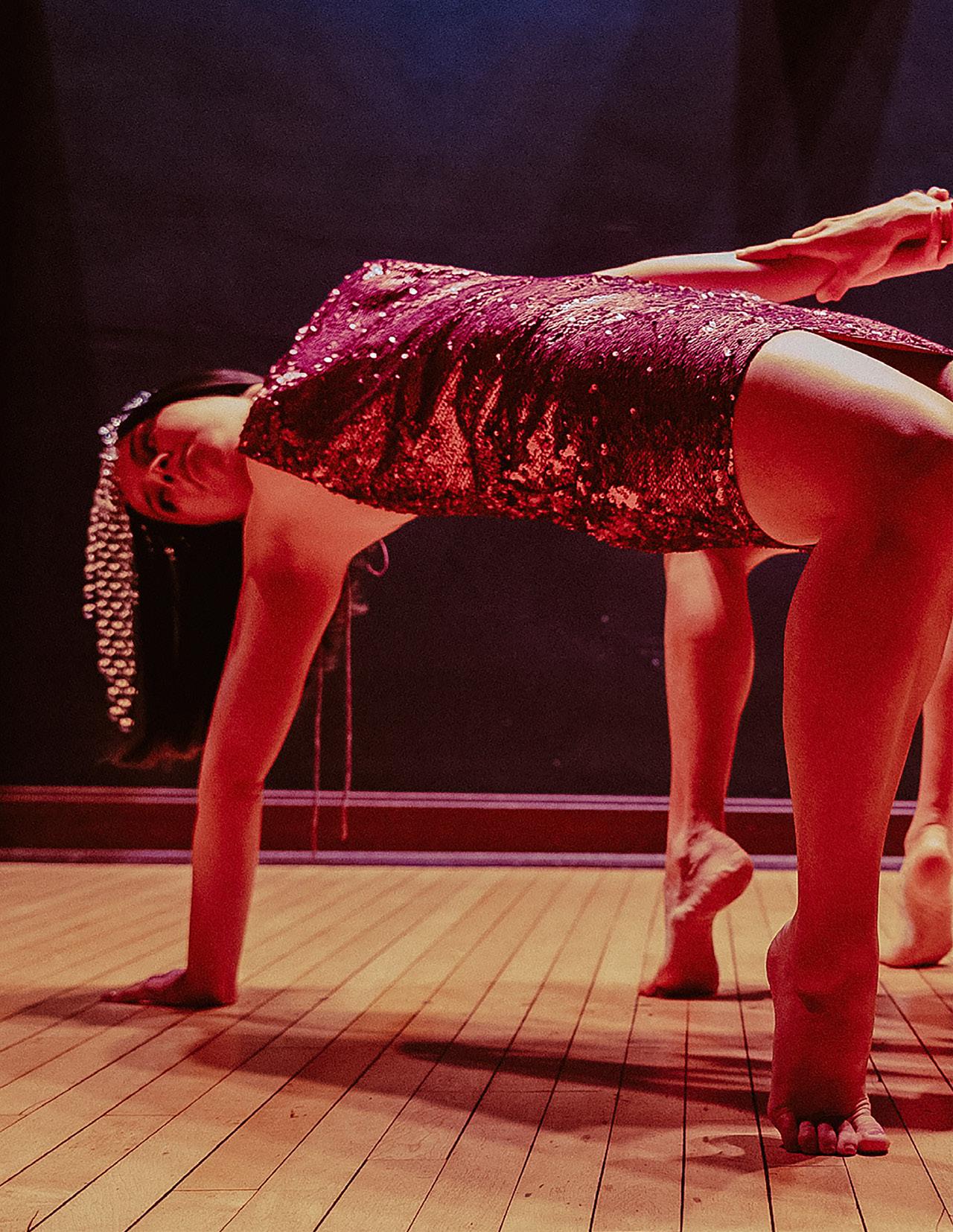 Directed by Sam Starks, Creative Director Assisted by Ella McCue, Alejandra Butcher-Salazar and Lily Dawson, Creative Staff Members, and Ally McNeive, Creative Contributor Photographed by Hunter Kiehl, Staff Photographer, Jessica Tenenbaum, Contributing Photographer, and Audrey O'Neill, Photography Director Makeup by Riley August, Makeup Director Modeled by Alexandra Mack, Online Editorial Assistant, and Clara McKinney Special Thanks to Mark Fairchild, Property Manager at Longfellow Lofts and Lynn Vilker, Board of Directors Member at Verona Area Community Theater
Directed by Sam Starks, Creative Director Assisted by Ella McCue, Alejandra Butcher-Salazar and Lily Dawson, Creative Staff Members, and Ally McNeive, Creative Contributor Photographed by Hunter Kiehl, Staff Photographer, Jessica Tenenbaum, Contributing Photographer, and Audrey O'Neill, Photography Director Makeup by Riley August, Makeup Director Modeled by Alexandra Mack, Online Editorial Assistant, and Clara McKinney Special Thanks to Mark Fairchild, Property Manager at Longfellow Lofts and Lynn Vilker, Board of Directors Member at Verona Area Community Theater

KINETIC
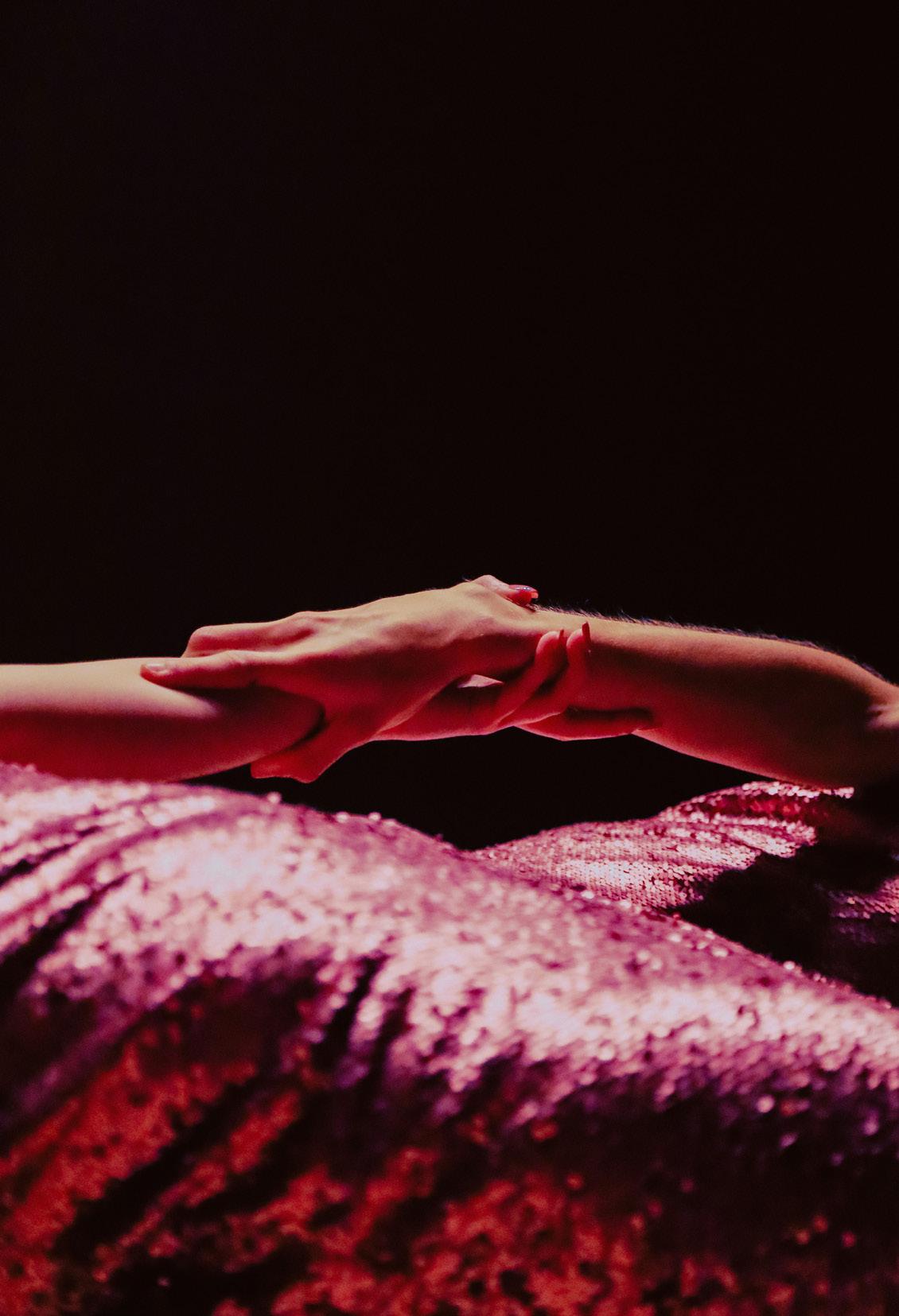
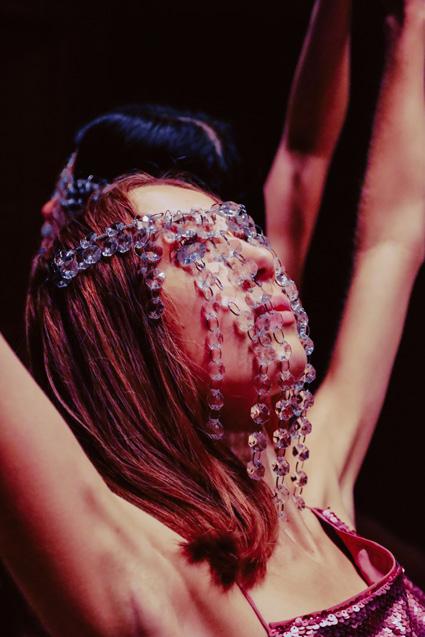
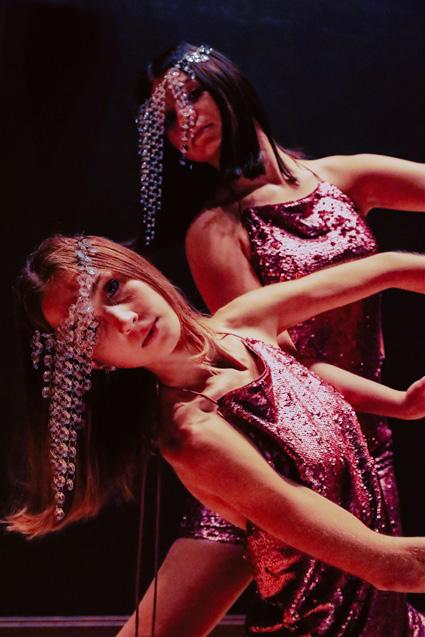
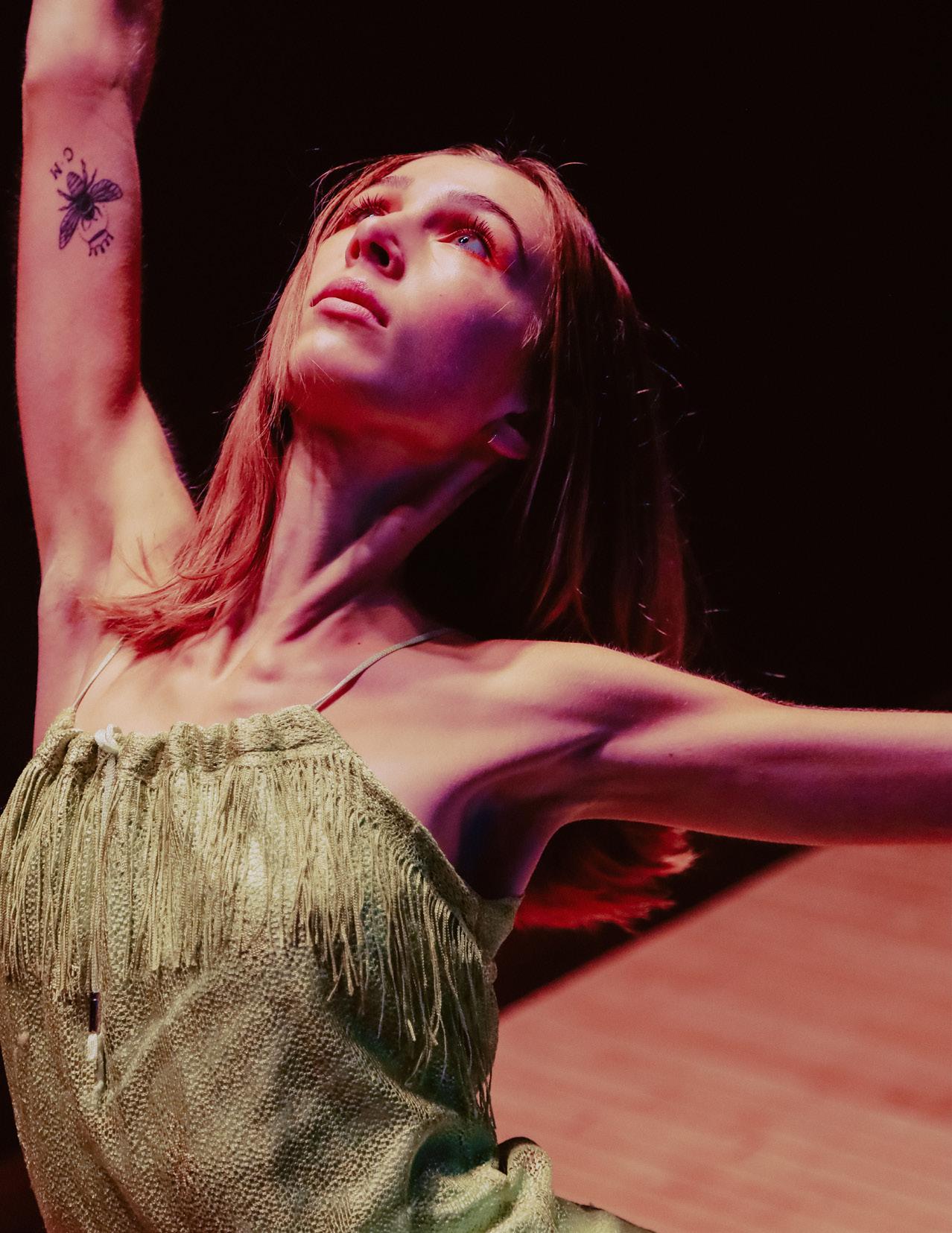
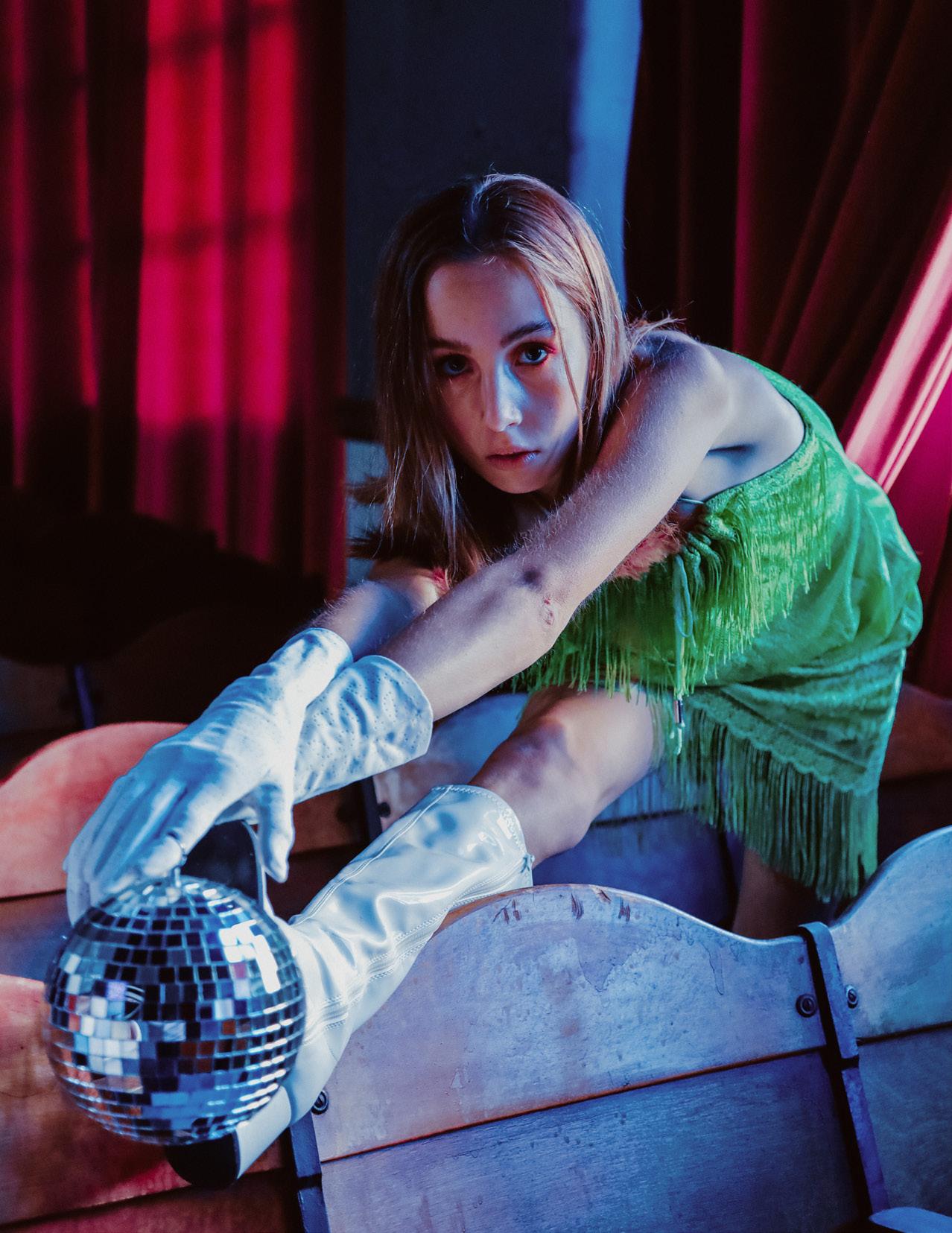
FEMALE FASHION POWERHOUSES
TWO WOMEN WHO CHANGED THE COURSE OF FASHION FOREVER
Written by Emily Fleming, PR & Outreach Director
Graphic by Kate Madigan, Staff Graphic Artist
JaneBirkin’s name may sound familiar, and it is likely because the infamous Hermes Birkin bag was created and named after her. She became an icon in the fashion world after her fame as an English singer, songwriter and actress skyrocketed in the late 1960s, and her influence has remained steadfast.
Birkin met the Hermes chief execu tive, Jean-Louis Dumas, by chance on a flight from Paris to London in 1983. Birkin complained to Dumas about her struggle of finding the perfect carry all bag, as opposed to her go-to straw basket, and rumor has it they spent the rest of the flight designing the perfect bag together.1 Three years later, the Hermes Birkin bag was revealed, and soon became one of the most valu able, expensive and highly sought-af ter handbags of all time.
Decades later, the Hermes Birkin bag still holds the title for most expensive purse ever created—with variations of the classic design ranging up to half a million dollars. While the bag certain ly fits the needs of what Birkin initially wanted, its popularity stems from its exclusivity.2 Yet the true intrigue be hind the story of the Birkin is not its price tag—it is the way its namesake, Jane, differs from nearly everything the bag stands for. She has only owned five Birkin bags in total, wearing each one until it is unusable, then auctioning off the used bags for charity. As for her yearly payment from Hermes for using her name? Every cent also gets donat ed to charity.
Brikin was never afraid to make a bold statement, which rang true when she started the trend of “defacing” her own signature bag. She added stamps and stickers to make her bags unique and true to her personality, claiming it to be her own way of making the bag less “snobbish.”3 This fit her signature ¹ “Who is Jane Birkin?” Baghunter, accessed Oct. 2021.
² Jack Houston and Anna Kim, “Why Hermès Birkin bags are so expensive, according to a handbag expert,” Business Insider, June 30, 2021.

³ “10 things you might not know about the Her
bohemian style, which was effort lessly cool and subtly sexy. From her love of mini dresses to her trademark fringe bangs, Jane Birkin was—and re mains—a fashion icon.4 She showed us the power in being true to yourself and the global impact that one can make being confident in their personal style. In this case, it all started with a clumsy straw basket!
to the ‘50s, where top models had hourglass figures, Twiggy transformed the fashion world by introducing the waif look.6 She expanded the defini tion of what it means to be sexy and feminine, creating an opportunity for girls who looked like her to feel con fident in their own skin and becoming the first model to be “truly celebrated for an androgenyous appearance.”7
Twiggy made history by bravely enter ing a judgemental industry at a young age with a look entirely different from what was commonly accepted at the time. She ranged from being the face of Mod Fashion in the ‘60s, which in cluded short skirts, shift dresses and bright color-blocking patterns, to em bracing the emblematic ‘70s hippie style, where she was spotted wearing velvet trousers, gogo boots, fringe, crochet, midi-style skirts, bell-bottoms and statement three-piece suits. Con tinuing to elevate and refine her dar ing style, she created persistent trends that will long continue to influence fu ture generations.
Another English figure who revolu tionized the fashion industry during this time goes by the name of Twig gy. Twiggy was known for her slender figure, bold eye makeup and short hair. After growing up in London, she moved to New York in the late ‘60s and immediately became an interna tional success. Given the childhood nickname “Twigs” by her friends due to her thin frame, her hairdresser and soon-to-be manager was the first to officially call her Twiggy.5 People de scribed her look as androgenyous and doll-like, and she was a pivotal fig ure “in shifting body type trends for women Body types being a trend at all should be ridiculed but for the sake of understanding influence sighting these trends is necessary. In contrast mès Birkin,” PurseBlog, April 25, 2018.
⁴ Jennifer Algoo and Charlotte Chilton, “Jane Birkin's stylish life in photos,” Harper's BAZAAR, April 28, 2021.
⁵ Jenna Curcio, “Twiggy's secret moments,” CR Fashion Book, March 28, 2019.
Today, Birkin celebrates the release of her first original album in over 10 years in her Paris apartment.8 Twiggy con tinues spilling over 40 episodes of se crets and advice on her podcast, Tea With Twiggy, including her outlook on life as she turns 71, her mark on fashion and her take on the industry’s future.9
The story of Jane Birkin extends far beyond the story of an infamous hand bag, and the tale of Twiggy is still be ing written to this day. Both women became the emblem of a movement—a force in fashion. Yet beyond their wild success, they never lost sight of their personal styles and passions.
■
⁶ Maria Hart, “See how much the “perfect” female body has changed in 100 years,” Greatist, Jan. 15, 2015.
⁷ Mina Dragani, “10 things you didn't know about '60s icon Twiggy,” L'Officiel, Feb. 21, 2021.
⁸ Jeff Weiss, “Jane Birkin is back with a new album, but her presence is everlasting,” The Washington Post, March 19, 2021.
⁹ Emine Saner, “Twiggy: 'I don't think high fashion will ever move completely away from Slimness,’” The Guardian, May 12, 2020.
FALL PRINT 2021
FASHION
A CONVERSATION ABOUT WHY DREAMS SHOULDN'T JUST BE LIVED IN THE FUTURE
Written by Olivia Peters, Social Media Manager
Photographed by Hannah Huber, Staff Photographer
 Modeled by Emily Herzog and Kamryn Truesdale
Modeled by Emily Herzog and Kamryn Truesdale
You’re

a full-time student. You’re balancing clubs, grades, family, friends, workouts, relationships, eating, cleaning and breathing. You feel worn thin. “That’s just college,” everyone says. “It’s only four years. Push through.” So you do, and you lose track of yourself. You forget what you like to do for fun, and you have no hobbies.

Suddenly, you’re graduating and you need a job. “Sell yourself,” they tell you. “Talk yourself up to those companies. It’s all about getting a spot.” So, you tell the people in suits sitting across from you exactly what they want to hear—even if it’s not fully honest, even if you don’t want the job.
You’ve always dreamt of sailing, it’s on your bucket list to skydive and you think it’d be fun to run a marathon. “There’s time in the future,” you tell yourself. “There will always be time to do the things I want later.” So you forget your aspirations, downgrading goals to simple daydreams.
Oftentimes, we find ourselves stuck in a pattern of inaction. It’s as if we’re wired to do what others expect rather than what we desire. Why do we pri oritize success over happiness? Some times, we do what’s expected of us so religiously that we become confused over what we truly want. It’s as though we’re waiting to live.
As college students, what are we wait ing for? Graduation? There is no start ing gun that tells you when to “Go!” As we leave college, a thousand more bar riers will pop up, things that feel like they need immediate attention. We’ll always be thinking, “There’s time in the future to do what makes me hap py,” until suddenly, there’s not. Goals shouldn’t be things we think of only in the future tense. How do we escape from going through the motions?
It’s hard to start things—sometimes, it’s physically painful to start moving. But there is an infectiously gratifying feeling that comes from simple ac
tions. That’s the power of forgetting the bullshit and simply doing.
Imagine how things could be if we stopped segmenting between profes sional aspirations and personal dreams. Nobody said we’re not allowed to have both, so let go of that assumption and stop pushing your happiness away.
You’re a full-time student. You’re bal ancing everything you need to. You have homework to do, club meetings to attend and a job. Yet, on Wednesday nights, you turn off your notifications and go to the lake to read. You haven’t read a book outside of class since you were in high school. Your books make you laugh and cry. You remember what it feels like to not be able to put a book down. It’s peaceful. You’re rediscover ing childhood joys.
Don’t let yourself lose sight of why you’re working so hard.
You’re graduating and you need a job. You interview with a company and know they aren’t a good fit for you. You respectfully decline and start go ing to your favorite coffee shop every other day to work on your portfolio. You apply to other places. You’re hon est with recruiters about what you’re looking for, and what environment you think you’d be successful in. You’re on the hunt.
If an opportunity doesn’t excite you, refocus your gaze on something that does.
You’ve always dreamt of sailing, it’s on your bucket list to skydive and you think it’d be fun to run a marathon. So you buy a boating sweater, incentiviz ing you to join the local sailing club. You look up the cheapest places to skydive in Wisconsin and text every single one of your friends, looking for takers. You put on tennis shoes after class a couple of times a week, turn on a podcast and start to run. You’re in motion, and you don’t want to stop.
That’s the power of doing.
■
MODA | 36
LIFESTYLE
Make way, Hollywood
THE GROWING POWER OF FEMALE DIRECTORS
Written by Cate Tarr, Arts Staff Writer Graphic by Nicole Glesinger, Contributing Graphic Artist
OnApril 21, 2021, I watched as unfamiliar faces on my TV vied for an award in the film directing category. It was the 93rd Academy Award ceremony: For the first time in history, two women were nominated for best director, and for the second time in history, a woman took home the award.1
Social media posts of praise and ex citement followed, but I was left un derwhelmed and full of questions. Why is our society one in which a woman winning an Oscar for best di rector is so out of the ordinary that it’s considered historical?
To quench my confusion, I decided to do some research; I expanded my un derstanding of why female film direc tors are a feeble club and also the ways this is beginning to change as women secure their footing in directing.
Historically, there has been low mobil ity for women in the high ranks of the film industry, yet recent changes re veal that progress is absolutely possi ble. What should be gleaned from this headway is not satisfaction, but moti vation as to how we can continue to amplify these advancements.
In the early years of the 20th centu ry, women worked in essentially every aspect of silent film making.2 Wom en were directors, writers, producers, actors and more. As the film industry cemented around a small number of leading studios around the 1930s, it grew harder for women to find head way in developing cinematic ventures.3
¹ Claire Shaffer, “Chloe Zhao Wins Best Director at Academy Awards: Watch her Speech,” The Rolling Stones, 2021.
² Margaret Talbot, “The Women Who Helped Build Hollywood,” The New Yorker, 2019. ³ Ibid.
Due to this, only 16% of film directors working on the 100 highest-grossing Hollywood films in 2020 were women. Shocking, right? Even more upsetting, this was a significant increase from the 4% that existed in 2018.
Despite the traditionally low numbers, this data illustrates how stress placed on studios to hire female filmmakers is resonating and resulting in palpable change. For the most part, this stress originates from compelling female voices in the industry. Kelly Nathe, a guest curator at the Walker Art Center in Minneapolis, Minnesota, created a tribute program to an annual film fes tival that the center ran from 1994 to 2010, called Women with Vision, which promoted female film directors.5
“A lot has changed in respect to aware ness and advocacy on behalf of wom en directors,” Nathe said. “. . . ’50/50 by 2020’ has been the battle cry on the festival circuit the past few years, and while most of the major festivals still have a way to go, most tout the percentages of films they have select ed that are directed by women, so the needle does seem to be moving in the right direction, slowly but surely.”6
Even if film festivals are simply fulfill ing a trend when promoting women in film, the publicity and support that female directors are receiving is unde niably giving them key exposure and agency. The Minneapolis St. Paul Inter national Film Festival, for example, cre ated a Women in Film Initiative.7
⁴ Brent Lang, “Women Directed Record Number of 2020 Films, Study Finds,” Variety, Jan. 2, 2021.
⁵ Miranda Harincar, “Then and Now: A History of Women with Vision,” Walker Art Center, March 5, 2020.
⁶ Ibid.
⁷ Ibid.
ed among filmmakers, have the least opportunities in film directing.8 Of the top 1,300 films released from 2007 to 2019, less than 1% of all directing jobs went to women of color.9 These statis tics uncover the stories, perspectives and talent not included in the media we consume and perpetuate the problem by showing individuals that there is no “space” for them.
The media we consume affects how we perceive the world, those around us and society as a whole. This means that there is great power in storytell ing, but also a great need for diverse voices, perspectives, backgrounds and beliefs. We see the stigma and rigid social norms that permeate older gen erations, largely due to the media they consume and the fact that the same old sexist plot tropes and storylines were constantly recycled. If women and those of other marginalized groups are excluded from shaping the collective narrative of the media, then they are excluded from having a role in shaping our worldly views and attitudes about society. Next Academy Award season, I hope to see people like me not only displayed but celebrated when the category for best director is called.
■

⁸ Anousha Sakoui, “Female Directors in Holly wood are still underrepresented, but the gap is narrowing,” Los Angeles Times, Jan. 2, 2020.
⁹ Ibid.
FALL PRINT 2021
ARTS
AIDS IN AMERICA
HOW THE FEDERAL GOVERNMENT LET DOWN ITS CITIZENS–AND HOW COMMUNITIES STEPPED UP IN ITS PLACE
Written by Maya Greenberg, New Members Director
Graphic by Annika Ide, Art Director

TheClubHouse was raucous, popular and the center of D.C. nightlife in the 1970s and ‘80s.1
With lines wrapped around the block, this nightclub drew in the same people week after week. However, in the early ‘80s, the club’s manager noticed that more and more regulars stopped showing up.2 Though he didn’t know it at the time, this observation was one of the first visible signs of the AIDS epidemic hitting D.C. Soon, AIDS was spreading across the nation, ushering in an era of American history defined by the hands-on involvement of communities mitigating the epidemic.
While communities jumped into action as they watched their members dying, the federal government remained un responsive and uncooperative. Public health agencies were already suffer ing in the early 1980s due to budget cuts made by the Reagan administra tion.3 The administration targeted the fight against AIDS in particular, as they stopped Congress from appropriating funds for AIDS-related programs and attempted to interfere with the CDC’s prevention campaigns.4
¹ Abdallah Fayyad, “The LGBTQ Health Clinic That Faced a Dark Truth About the AIDS Crisis,” The Atlantic, July 22, 2019.
² Ibid.
³ Tasleem J. Padamsee, “Fight an Epidemic in Political Context: Thirty-Five Years of HIV/AIDS Policy Making in the United States,” Oxford Aca demic, Dec. 28, 2018.
⁴ Ibid.

Nothing summed up the federal re sponse more than when President Ron ald Reagan’s press secretary openly joked that AIDS was the “gay plague.”5 The disease was seen predominantly as a threat to gay men and was often used as a way to further marginalize already oppressed groups. Starting with Reagan and upheld by Bill Clinton (later to be reinstated under Barack Obama), bans were placed on the use of federal funds for needle exchange programs. The claim was that these programs would increase drug use, and while this was unsubstantiated, the effect the ban had on the public health of gay and black communities was real.6 This stigma is still obvious today. Even though restrictions have been loosened due to the high de mand for blood and plasma during the COVID-19 pandemic, many clinics will still turn down gay and bisexual donors who have had sex within three months leading up to the donation.
As quickly as the Reagan administra tion decided that AIDS and HIV were not its problems, communities took the epidemic head-on. Activist and psychiatrist Dr. Jesse Peel told CNN that for a lot of gay men living in big ⁵ German, Lopez, “The Reagan administration’s unbelievable response to the HIV/AIDS epidem ic,” Vox, December 1, 2016 ⁶ Abdallah Fayyad, “The LGBTQ Health Clinic That Faced a Dark Truth About the AIDS Crisis,” The Atlantic, July 22, 2019.
cities, the ‘70s were initially all about sex, drugs and rock n’roll.7 But this atti tude quickly shifted after the spread of AIDS, and LGBTQ+ communities were forced to band together and take care of one another in the wake of an ap athetic government. In an almost im mediate response to the outbreak in D.C., the ClubHouse supported their ill patrons by collecting money for rent and bills.8 Other organizations like the Whitman-Walker house used funding from the city to implement syringe ex change programs to slow the infection rate of injection-drug users.
Alongside grassroots organizers, artists and visionaries used their re sources to try to reach the public. In an Atlanta theater in 1984, playwright and author Rebecca Ranson’s orig inal play titled “Warren” debuted.9 Considered the first play about AIDS, its aim was to reach and educate a larger public demographic that may otherwise have very little contact with the virus and its effects. In 1989, the Atlanta-based publication com pany Nexus Press hosted America’s first art exhibition with AIDS as the focus 10 These efforts made it clear that urban communities were doing whatever they could with limited re ⁷ Jen Christiansen, “AIDs in the ‘80s: The rise of a new civil rights movement,” CNN, June 1, 2016.
⁸ Ibid.
⁹ Ibid.
10 Ibid.
sources to try to spread information and awareness about AIDS.
CNN dubbed this collective effort as “the rise of a new civil rights move ment.”11 Unfortunately, this movement was formed out of absolute neces sity. It came out of a time when even doctors were debating whether or not they had a moral obligation to treat pa tients with AIDS and individuals were shunned by their churches and families for having the disease. Polls taken in the late ‘80s showed that more than one in five Americans were more un comfortable around gay friends and aquaintances, and over half of Amer icans believed it was an individual’s fault if they contracted AIDS.12 Further more, more than one in five Americans felt that those with the virus should be isolated entirely from society.
Eventually, celebrities began to come forward as advocates for individuals with AIDS, and public opinion shift ed slightly. In the late 1980s, Princess Diana began advocacy work for HIV/ AIDS patients both in the United King dom and in America.13 During a time where nurses were reluctant to even serve food to AIDS patients, she broke
11 Ibid.
12 Justin McCarthy, “Gallup Vault: Fear and Anx iety During the 1980s AIDS Crisis,” Gallup, June 28, 2019.
13 Emma Dibdin, “The True Story Of Princess Diana's Groundbreaking AIDS Advocacy,” Elle, Dec. 6, 2020.
ground by shaking hands with and hugging them. However, even celebri ty status couldn’t protect those who were HIV positive from scrutiny. When Freddie Mercury announced that he was HIV positive and had AIDS, many activists were upset that he’d kept it a secret for so long and hadn’t advocat ed for other AIDS patients.14 Famous or not, the stigma surrounding AIDS made living with the illness an obstacle to everyday activities.
In the time since the onset of the epi demic, the fight against HIV and AIDS has come a long way in America. Treat ments now exist to reduce HIV in af fected people’s systems, often get ting the virus under control within six months.15 The FDA has also approved a new drug called Descovy that serves as a preventative measure for individuals at risk for contracting HIV.16 Attitudes surrounding individuals with the virus have also seen some improvements. In 2010, the United States finally lifted the Reagan era ban on HIV-positive in dividuals entering the country,17 a ban
14 “Freddie Mercury’s AIDs Announcement Dis appointed Activists,” Showbiz Cheatsheet, Aug. 17, 2021.
15 “HIV Treatment,” Center for Disease Control and Prevention, May 20, 2021.

16 “FDA approves second drug to prevent HIV in fection as part of ongoing efforts to end the HIV epidemic,” U.S. Food and Drug Administration, Oct. 3, 2019.
17 Steve Connor, “US lifts ban on foreigners with HIV imposed by Reagan,” Independent, Jan. 5, 2010.
that Obama had described as “rooted in fear rather than fact.” Though these instances have been huge strides, they have not happened without re sistance from the government and so ciety. Although the epidemic is often only looked at in terms of sickness and death, it has led to a new generation of advocates who continue to make change possible.
As the fight against AIDS continues, there are small things that every per son can do to make a difference. Sup port your local community centers, vote for politicians who will provide quality healthcare and, if you are sex ually active, get tested regularly and disclose your status with any part ners. Lastly, understand that AIDS continues to ravage other parts of the world. South Africa has the highest percentage of people suffering from the disease, and many of these indi viduals are sex workers, transgender women and drug users—creating an even steeper battle towards receiv ing just agency.18 If you or a loved one are living with a sexually transmitted disease, know that there are resourc es available and you should not be ashamed to seek them out. Visit the Center for Disease Control and Pre vention for more information. ■
18 Sara M. Allinder, “The World’s Largest HIV Ep idemic in Crisis: HIV in South Africa,” Center for Strategic and International Studies, April 2, 2019.
CULTURE
THE NEW MEANING OF A FASHION STATEMENT
SOCIAL ACTIVISM THROUGH FASHION
 Written by Manon Bushong, Fashion Editor
Graphic by Sammy Meyerson, Contributing Graphic Artist
Written by Manon Bushong, Fashion Editor
Graphic by Sammy Meyerson, Contributing Graphic Artist
WhenAOC flaunted a dress at the Met Gala that read “tax the rich,” it sparked a lot of controversy. A considerable reason why this look was so heavily judged stems from the fact that she wore it to an event with tickets priced at a steep $35,000. Some praised her for pushing a political agenda, but others felt the effort was tone-deaf.
Does incorporating activism into the realm of fashion always need to feel forced and insincere? Or can this be an effective way to shed light on import ant topics to high volumes of people?
When we acknowledge that fashion, at its core, is a form of art, it makes perfect sense why we frequently see it used to articulate deeper meaning. One designer who uses her platform to spark conversation is Tracy Reese. Re ese accompanied her Fall 2017 Ready to Wear runway show with young fe male poets’ reciting their work.1 These words exemplified her designs, all of which aimed to appeal to fashionable yet professional women. Rationing her spotlight with these writers made it clear how much Reese values empow ering young women. Additionally, Re ese organized for “Fashion Stands with Planned Parenthood” pins to be hand ed out at official New York Fashion Week venues,2 an ultimately well-re ceived initiative.
Reese has also been a strong force in the sustainable fashion movement. In 2019 she created a label called Hope for Flowers. The garments for this la bel are in part manufactured in Mich igan, a location Reese hopes one day will be the primary location for sus tainable clothing production in the United States.3
Designers appending issues to the dis play of their collections the way that Reese did is one form of fusing fashion
¹ Emily Farra, “Tracy Reese Fall 2017 Ready-toWear,” Vogue Runway, 2017.
² Ibid.
³ Elizabeth Segran, “Move over L.A. Detroit is gunning to become America’s next Garment District,” Fast Company, 2021.
and activism. However, there are some people whose entire careers lie in bet tering the fashion industry itself. Fea tured in Forbes Europe’s 30 under 30 - Technology, Eshita Kabra has made a name for herself in fashion while also minimizing clothing waste.4 Kabra is the founder of By Rotation, a growing app for borrowing and lending cloth ing.5 This app offers a powerful solu tion to combating the overconsump tion problem that has led to major environmental consequences, while also satisfying those who love to con stantly change up their wardrobes. The app is super community oriented; all of the pieces come from users rather than being owned by the app itself. This ap proach has appealed to over 100,000 users in the UK,6 and has played a cru cial role sparking a change in the way we consume.
On a similar note, Hunter Shafer launched her name through her role on HBO’s cult series “Euphoria,” but her career began in New York when she was full time modeling after be ing scouted by the agency Elite.7 While Shafer has said numerous times she does not consider herself an activist, she is extremely vocal about her experience as a transgen der woman and advocates heavily for the LGBTQ+ community.
In 2016, the then 17-year-old Shafer participated as a plaintiff to a law suit against North Carolina’s discrim inatory “bathroom bill,” which did not protect LGBTQ+ folks againstant discrimination laws.8 Fast forward to 2021, when Shafer became a Met Gala showstopper in an extremely Alienlike 1999 Prada gown.9 Recently, she
⁴ “30 Under 30 Europe 2021 - Technology,”
Forbes, 2021.
⁵ Eshita Kabra-Davies, “Founder of By Rotation: from side hustle to six figure business,” Drapers, 2021.
⁶ Ibid.
⁷ Leigh Nordstrom, “Hunter Schafer, Hollywood’s New Obsession From the Fashion World,” WWD, 2019.
⁸ Katherine Cusumano, “Rising Model Hunter Schafer Is Fighting for the Future of Trans Indi viduals On and Off the Runway,” W Magazine, 2018.
⁹ Laura Regensdorf, “How Hunter Schafer Slipped into an Alien Alter-Ego for the 2021 Met Gala,” Vanity Fair, 2021.
also became the face of Prada, star ring in an elegant and retro campaign for their new Prada Galleria handbag.10 The growth of Shafer’s career has not altered her outspokenness on issues relating to LGBTQ+ rights. She has gone above and beyond in her “Eu phoria” role as a transgender teenage girl, offering a sort of raw and unpar alleled form of representation for the young trans community.
Although activism appears to be tak ing the fashion industry by storm, it is important to note that some brands will instigate campaigns merely as PR stunts. Following the murder of George Floyd, it felt as though every company was taking to social media to announce their support of the Black Lives Matter movement. When sus tainable LA clothing company Refor mation participated in this Instagram phenomenon, they faced immediate backlash after numerous employees came forward with examples of the company’s racist work environment.11 Unfortunately, this situation highlights how insincere and ill-motivated com pany statements about social justice can be, and emphasizes how—beyond statements—action is a crucial aspect of brand activism.
Activism within the fashion realm has been undoubtedly on the rise. While there is certainly a phony aura to a considerable amount of acts of so cial justice performed by designers, models and influencers, we cannot let this hinder the real change that those with powerful platforms have brought about. Whether it be a designer shar ing their spotlight, an entrepreneur engineering a new way to dress sus tainably or a model who uses their in fluence to push for social change, it is exciting to witness powerful figures in the fashion industry making a differ ence with their platforms.
■
10 Mario Abad, “Hunter Shafer Lands her First Prada Campaign,” Paper Magazine, 2021.
11 Kara Nesvig, “Reformation Founder Yael Alfalo Resigns After Allegations of Racism,” Teen Vogue, 2020.
MODA | 40
FASHION
How Children's Books Pack a Punch
WHY WE SHOULDN'T UNDERESTIMATE MIDDLE-GRADE FICTION
Written by Kora Quinn, Arts Editor
Graphic by Rosie Quinlan, Contributing Graphic Artist


I’ve
been an avid reader all my life, but at the age of eight, the only criteria I had for the books I read were entertainment and relatability— which seems obvious, considering my favorite series was “Junie B. Jones.” But after reflecting on the books I read as a kid and reading more children’s books as an adult, I now realize that there’s much more to middle-grade fiction than most people realize.
“Middle grade” is a broad category, but it is usually defined as books targeted at children from ages eight to 12. Some famous middle-grade series you may have read include “Harry Potter,” “Per cy Jackson and the Olympians” and “A Series of Unfortunate Events.” These books usually deal with social top ics that their target audience is likely to encounter, such as friendship, first crushes, parental relationships, emerg ing sexuality and bullying. Since they’re told from the point of view of children, these topics are handled in comedic and subtle ways, opting to entertain rather than make a statement.
defined. Over time, readers of any age started to move fluidly between these categories, blurring the lines. This has led to confusion among both consum ers and the publishing industry about what defines middle-grade versus young adult books.1
Amidst this confusion, many publishing professionals and librarians agree that misidentifying middle grade as young adult is in some ways disrespectful and condescending, as it comes from the belief that children’s books don’t have the ability to cover difficult and hard-hitting topics.2 That perception is simply not true.
“See You in the Cosmos” by Jack Cheng is one of the many complex middle-grade books that deal with mature and difficult topics, but are in tended for young readers. On its sur face, “See You in the Cosmos” is about Alexander Petroski, an 11-year-old boy who wants to build a rocket and launch his iPod into space for aliens to find. Together with his dog, Carl Sagan, Alex travels across the U.S. trying to achieve this dream.
Corrina Allen, a 5th-grade teacher, speaks to the importance of “mature” topics in middle-grade books in her podcast, “Between Books.” She says, “I am sure you know of many, many
Still, there is some ambiguity today on what the intended age range of mid dle-grade fiction is. In the past, chil dren’s “chapter books” had stricter cat egories, with books for young readers, new teens and young adults distinctly
Some people might see this as a fun story about a smart kid who has big dreams. I read it at 18, and I saw a heart-wrenching story about a ne glected child who must navigate life not only with a single mother but with a parent who has undiagnosed schizo phrenia and a distant brother who doesn’t make time for his struggling family. But the way you interpret this book will depend on your life experi ences, not necessarily your age.
¹ Shannon Maughan, “Navigating Middle Grade Books,” Publishers Weekly, April 13, 2018. ² Ibid.
children who are dealing with some tricky situations. And that’s the stuff we know about—imagine all the things that are just too painful or complicated for them to even bring up. These books help kids realize they’re not on their own. These novels let kids see a path through adversity through the actions of a character. And maybe the ending is not perfect, but there is a way to get through it.”3
And that’s why middle-grade fiction is powerful, because it helps children see their experiences reflected back at them in ways they’ll understand. It also serves as an entry point for young readers who can handle tougher top ics—especially as these topics relate to their current social lives—but who aren’t ready for these topics to be portrayed in more explicit detail. Mid dle-grade books introduce children to more nuanced views of the world in subtle and easily digestible, yet potent, ways by meeting them where they are at and helping them understand where they might be.
■
³ Corrina Allen, “The Importance of Books That Tackle Tough Topics: Books Between, Episode 5,” All the Wonders, Aug. 29, 2016.
FALL PRINT 2021
ARTS


MODA | 42















